THE LINK to #urbanana:
From Koelnmesse to Mediapark – Colonia’s Cluster
in English: 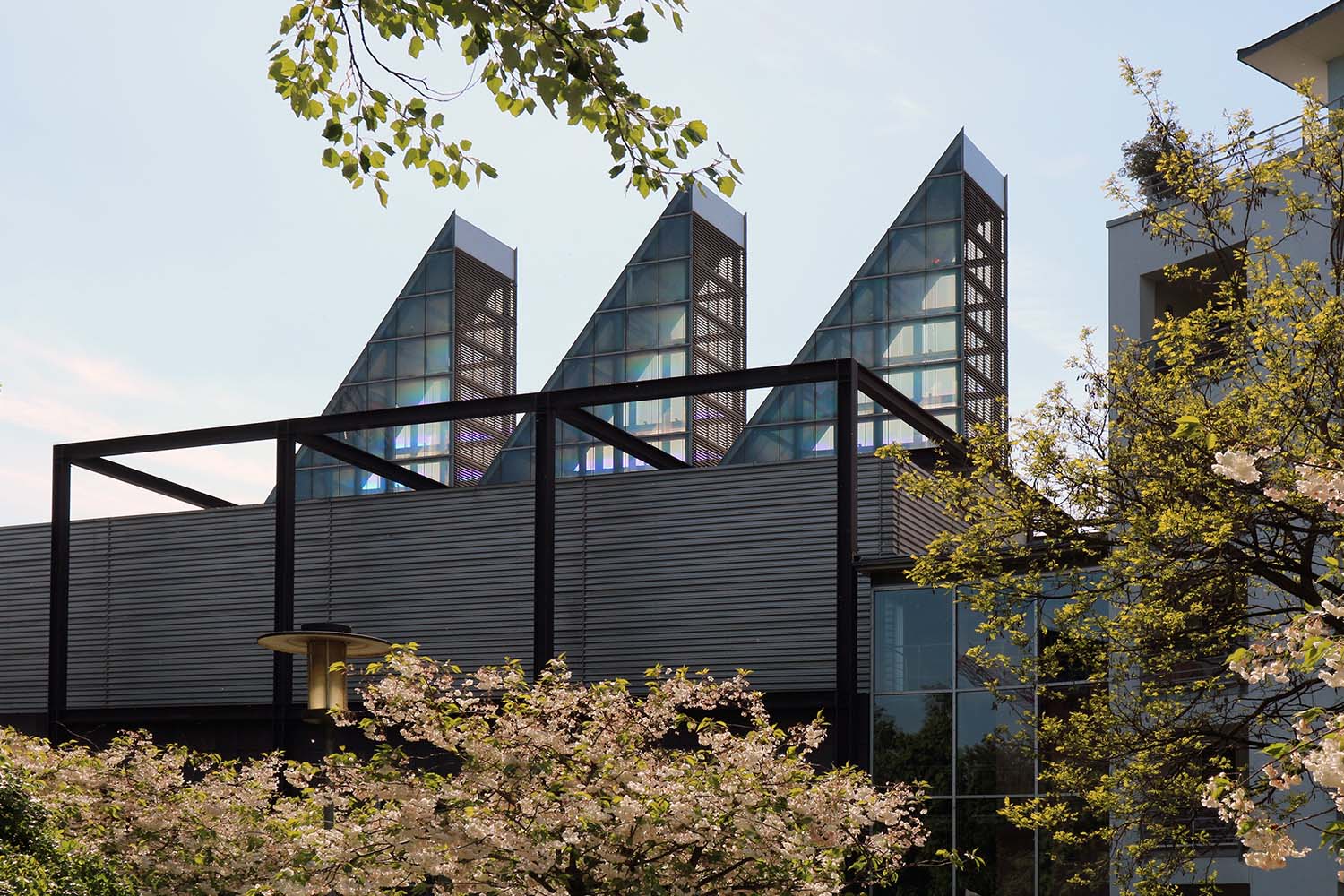
The German version: here.
»Nothing stays the way it was.
(Be open to innovation.)«"Kölsches Grundgesetz" or Cologne Constitution with 11 sayings ("op Kölsch") about life.
Whoever comes to Cologne for the first time sees a chaotic multiformity, through which a considerably wide river flows. The city’s puzzle-like face consists of vestiges of the Roman era, 1950s filigree, steel-and-glass towers, palatial residences with two-storey gables and this black colossus of a church that towers over everything, no matter your perspective as you toward the cathedral square. Forever and ever, amen. Cemented fast. Hardened. Immovable. Or so it was thought, since things were only built, adjusted, and expanded at and around this gothic giant.
In order to avoid the heart attack caused by this teeming architecture, I suggest that those arriving by train take the exit at the KölnMesse/Deutz station (those arriving by car who wish to evade the knotty mess that is Cologne traffic should also park here). Try it, because then this place becomes an urban-Rhine landscape painting. After you have gotten a feeling for how tremendously large the exhibition centre property is, have headed past the KölnTriangle, and are standing at the Kaiser Wilhelm equestrian statue, an adjective most unusual for Cologne may come to mind—beautiful! (With an exclamation point.) To keep this sense of goodwill afloat, continue with the M&M tour (Messe & MediaPark tour). This tour consists in part of the Via Culturalis, the spiritual-cultural-political heart of things, and more so of the Via Sacra, the large ring route at the edge of Cologne’s old city, which gives the visitor a sense of how Cologne acted as a medieval metropolis. The M&M tour starts with the Koelnmesse and ends at the MediaPark; it is not always the prettiest side of the fourth-largest city in Germany, but it is certainly one of the most exciting, from an architectural point of view. Guaranteed? No, there’s too much to see for that, the distractions are too great, the roaring too vibrant. Clusters are groups, accumulations, a swarm. The architectural agglomeration is enormous. For visitors, the XXL swarm on an XXS area has an advantage: in this dense cluster-city, one can be in the Roman era one moment and in the plans of the Koelnmesse 3.0 the next. In music, the word cluster stands for a sound structure whose tones lie close to one another. Cologne, you sound good.
Koelnmesse: Huge, Forthcoming Possibilities
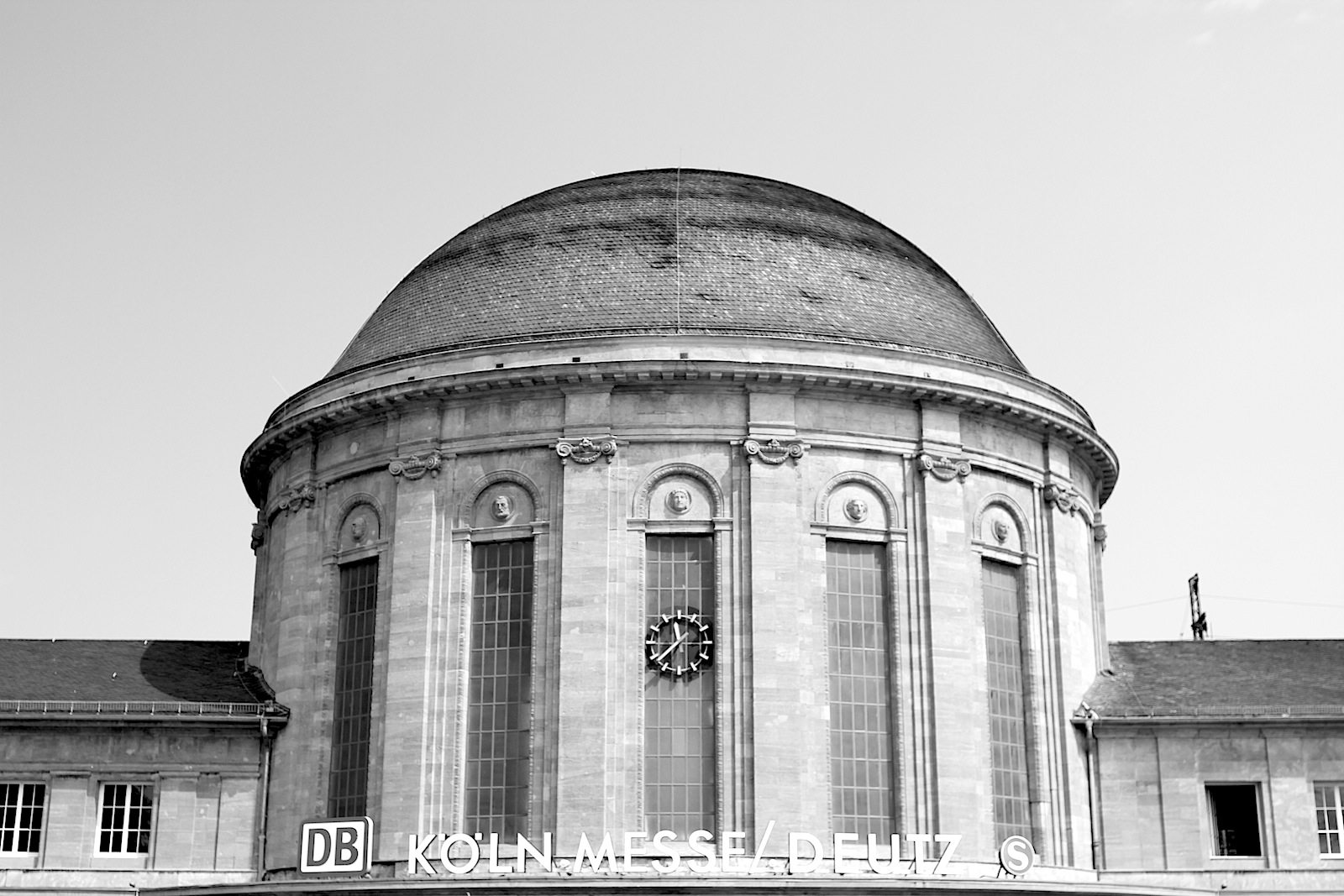
KölnMesse/Deutz station
Arrival and entrance gate to the exhibition centre. Among others the following trade fairs are held in Cologne: Anuga, Art Cologne, Photokina, Gamescom, Imm Cologne.
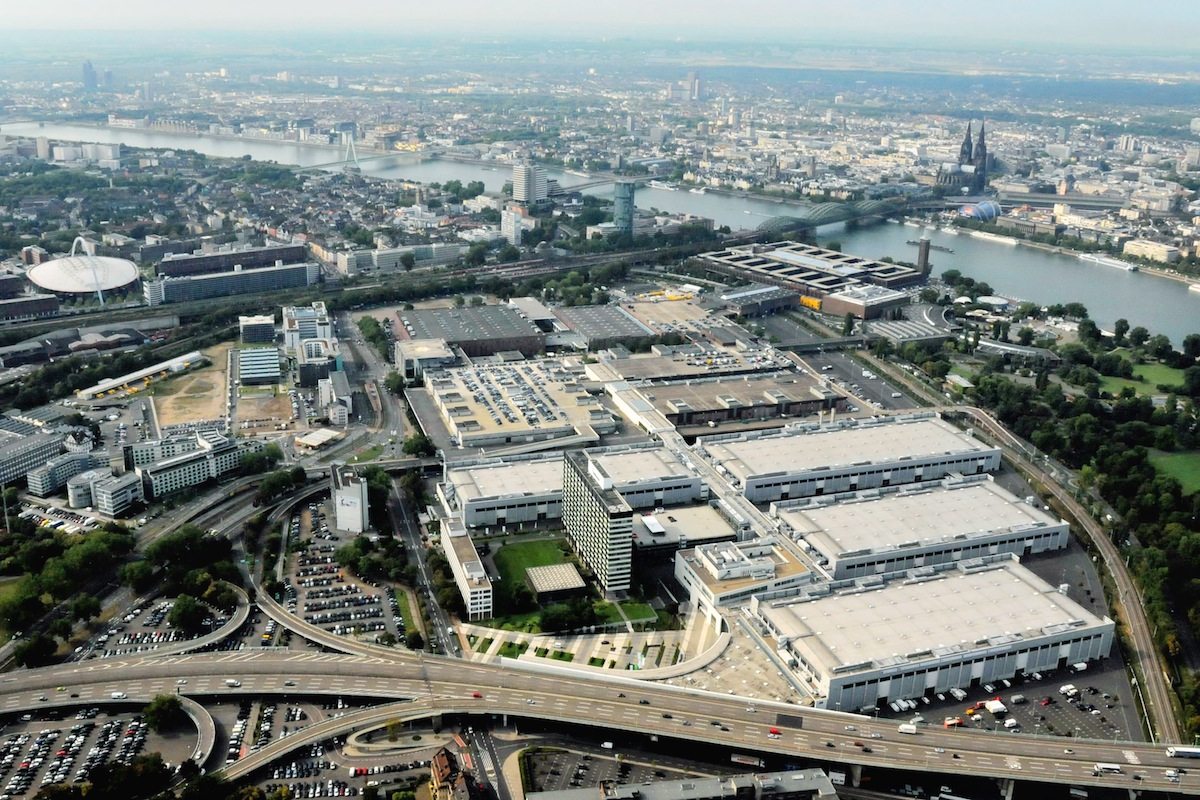
Aerial view of the Koelnmesse
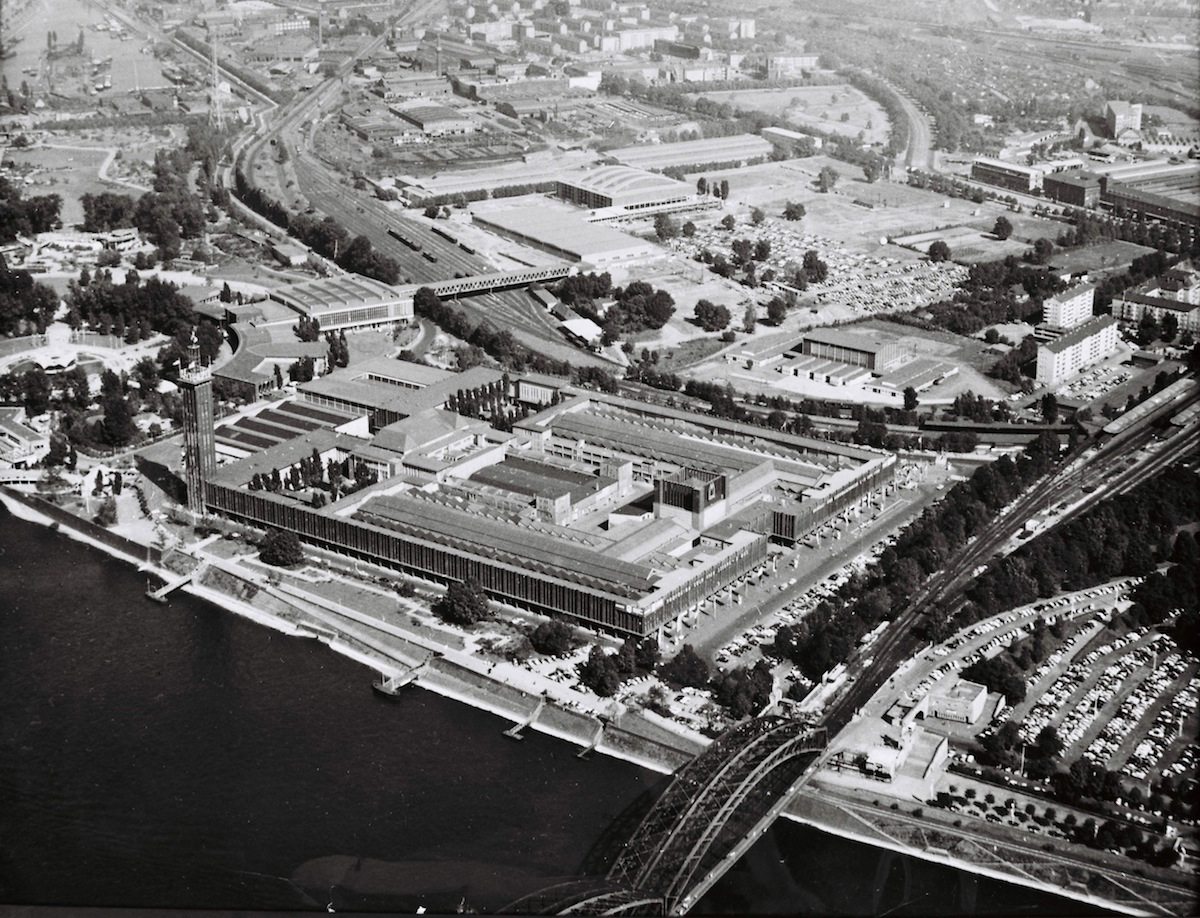
1960
Aerial view of the exhibition grounds with hall 10 and indoor arena.
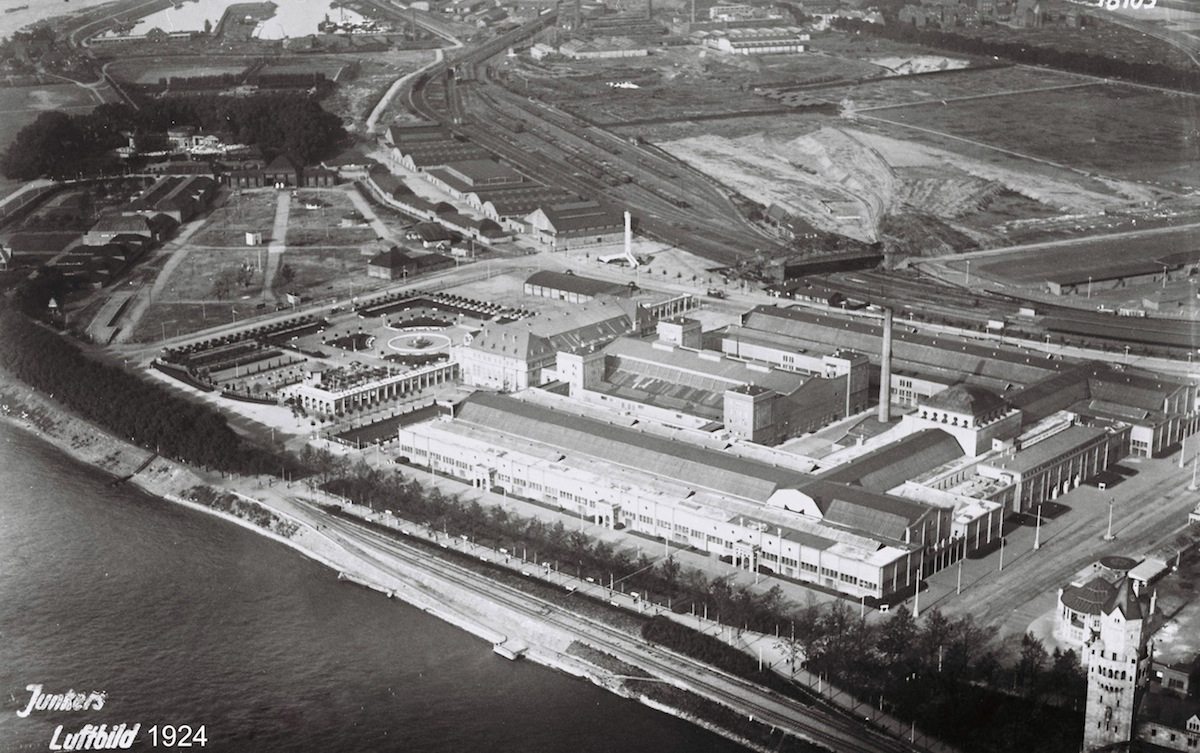
Aerial view
of the trade fair halls, called "Mr. Adenauer's stables"
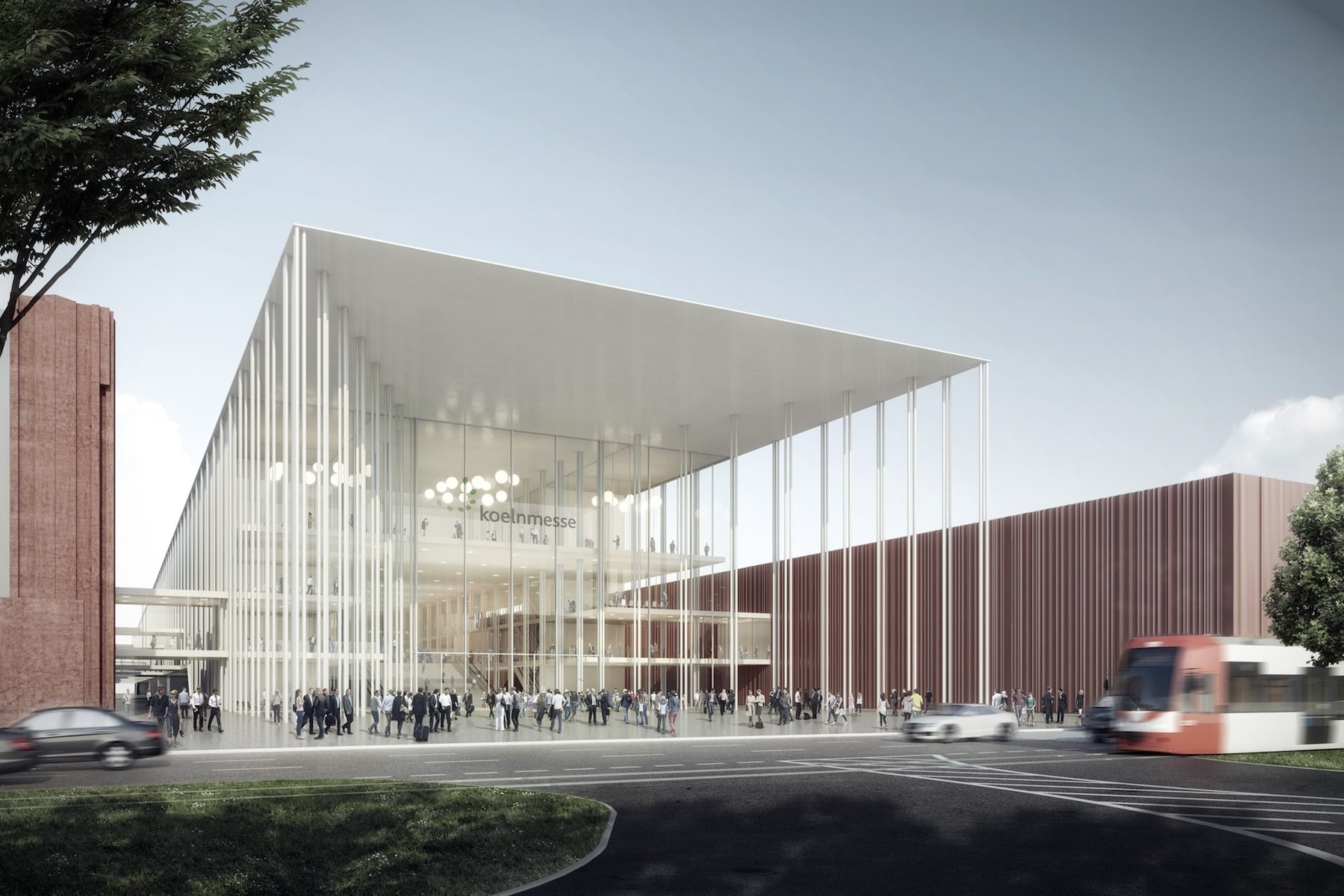
Winning design by JSWD Architekten, Cologne
Architects' competition for Koelnmesse 3.0, draft Entrance East

KölnTriangle
is a 103.2 metres tall building in Deutz, and a prominent landmark in Cologne. The building was designed by Dörte Gatermann of Cologne-based architecture firm Gatermann + Schossig and completed in 2006.
Rhine: Panorama and Urban Splendour
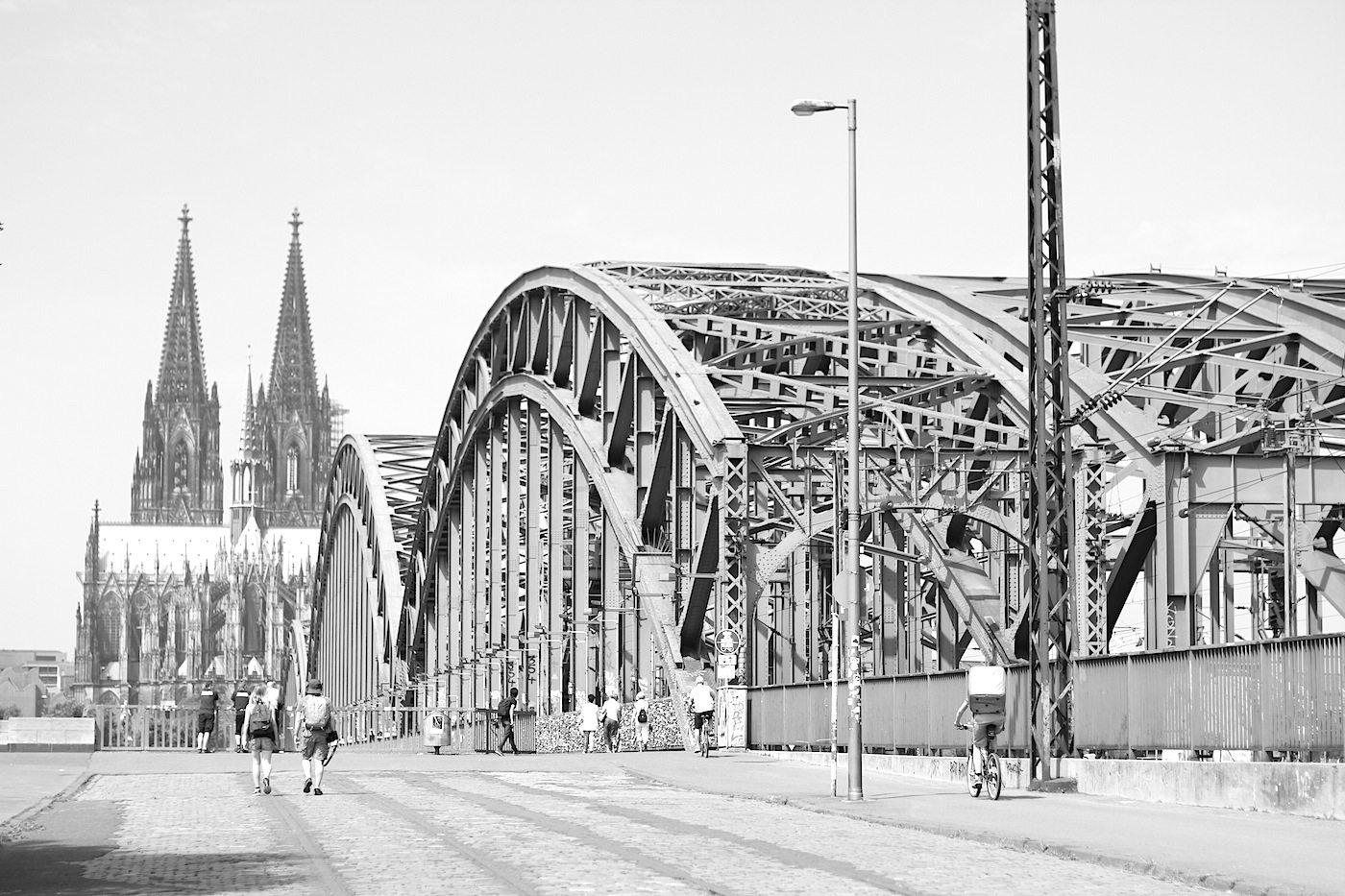
Cologne Cathedral
German: Kölner Dom, officially Hohe Domkirche Sankt Petrus from the East with the Hohenzollernbrücke.

Wilhelm I.
Four equestrian statues of Prussian kings and German emperors of the Hohenzollern family flank each ramp. The Cathedral Bridge was already adorned with the statues of Friedrich Wilhelm IV of Prussia by sculptor Gustav Blaeser and Kaiser Wilhelm I by Friedrich Drake.
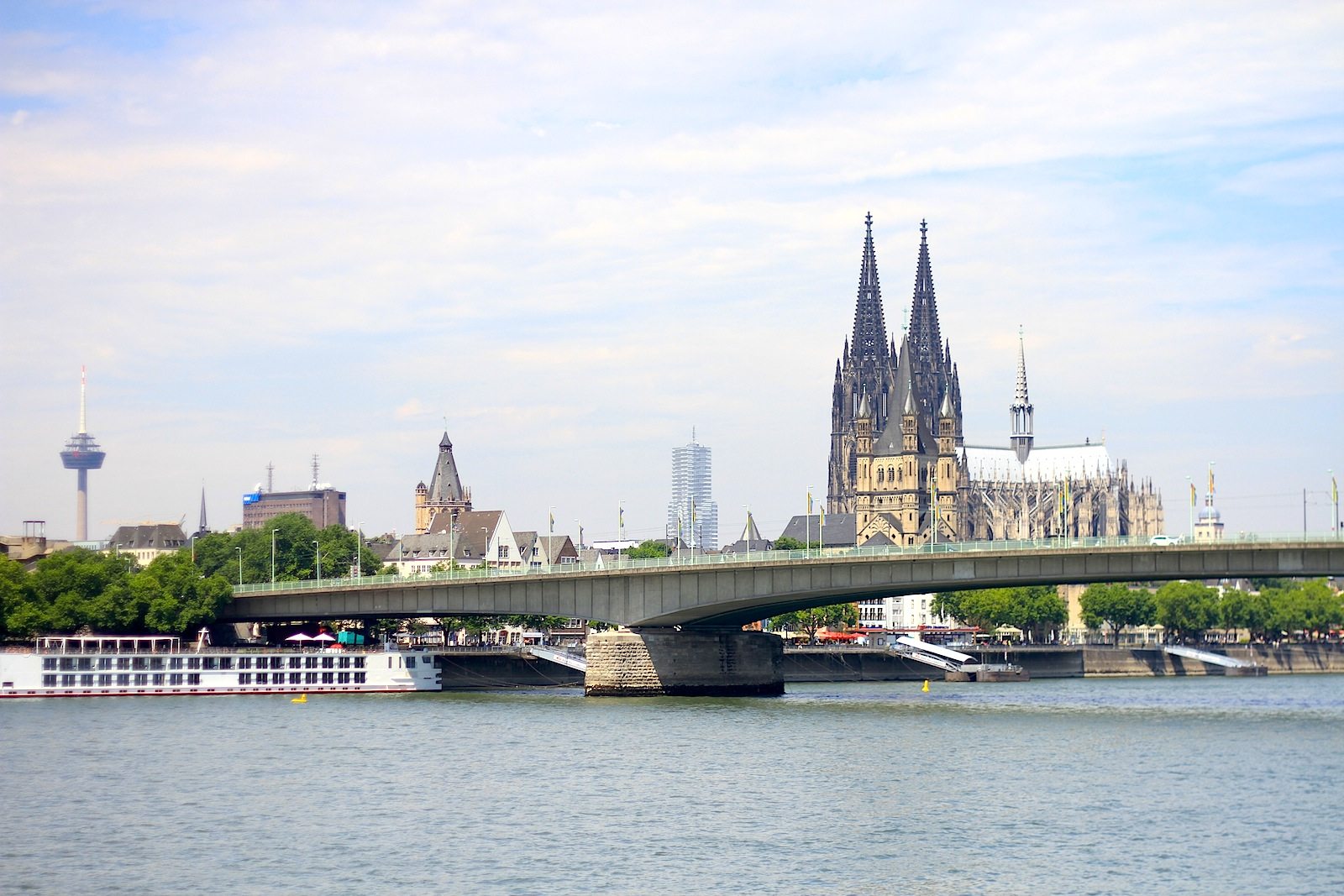
Altstadt of Cologne
Deutzer Brücke with the Cathedral (Dom), Cologne Tower (KölnTurm), town hall, WDR, TV tower Colonius.
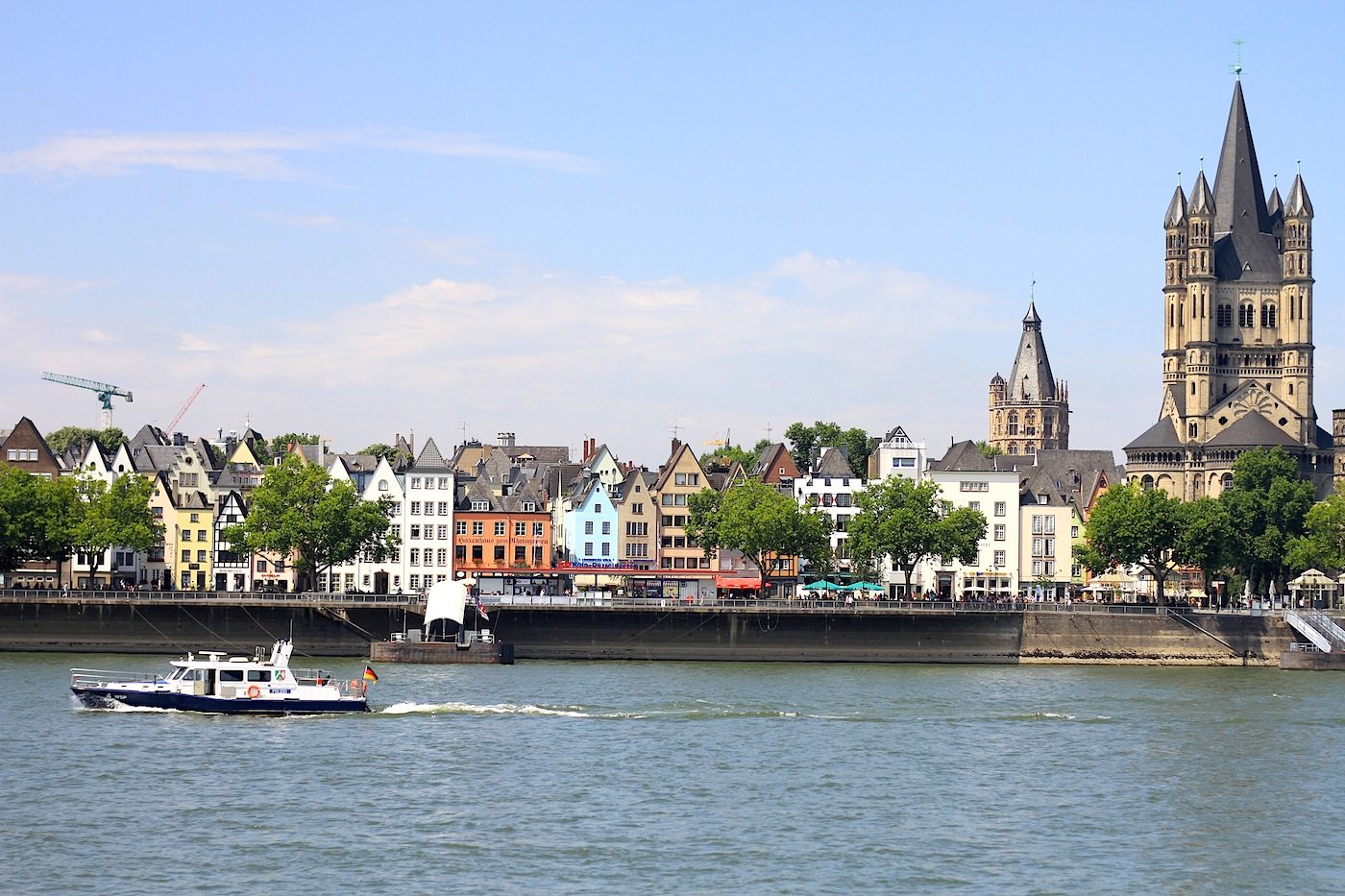
Martinsviertel
with Great St. Martin Church. Take the Hohenzollernbrücke from KölnMesse/Deutz station until Cologne Central Station, our next stop.
Central Train Station: Arrivals and Departures
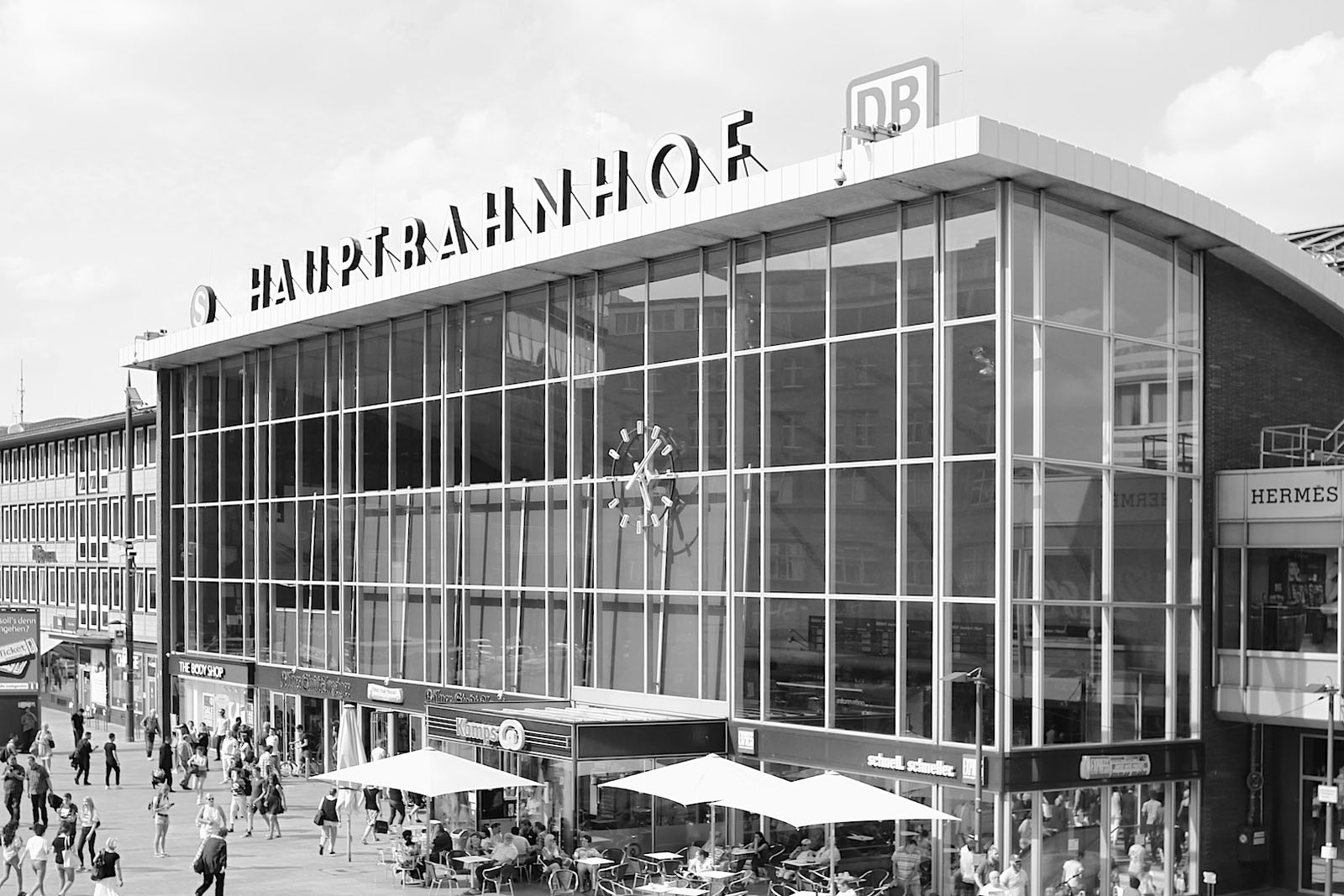
Cologne Central Station
In September 1957, the new reception hall, built according to plans by architects Schmitt und Schneider, was opened. With its bowl-like roof structure and full-glass facade it presents itself as a transparent, seemingly filigree building.
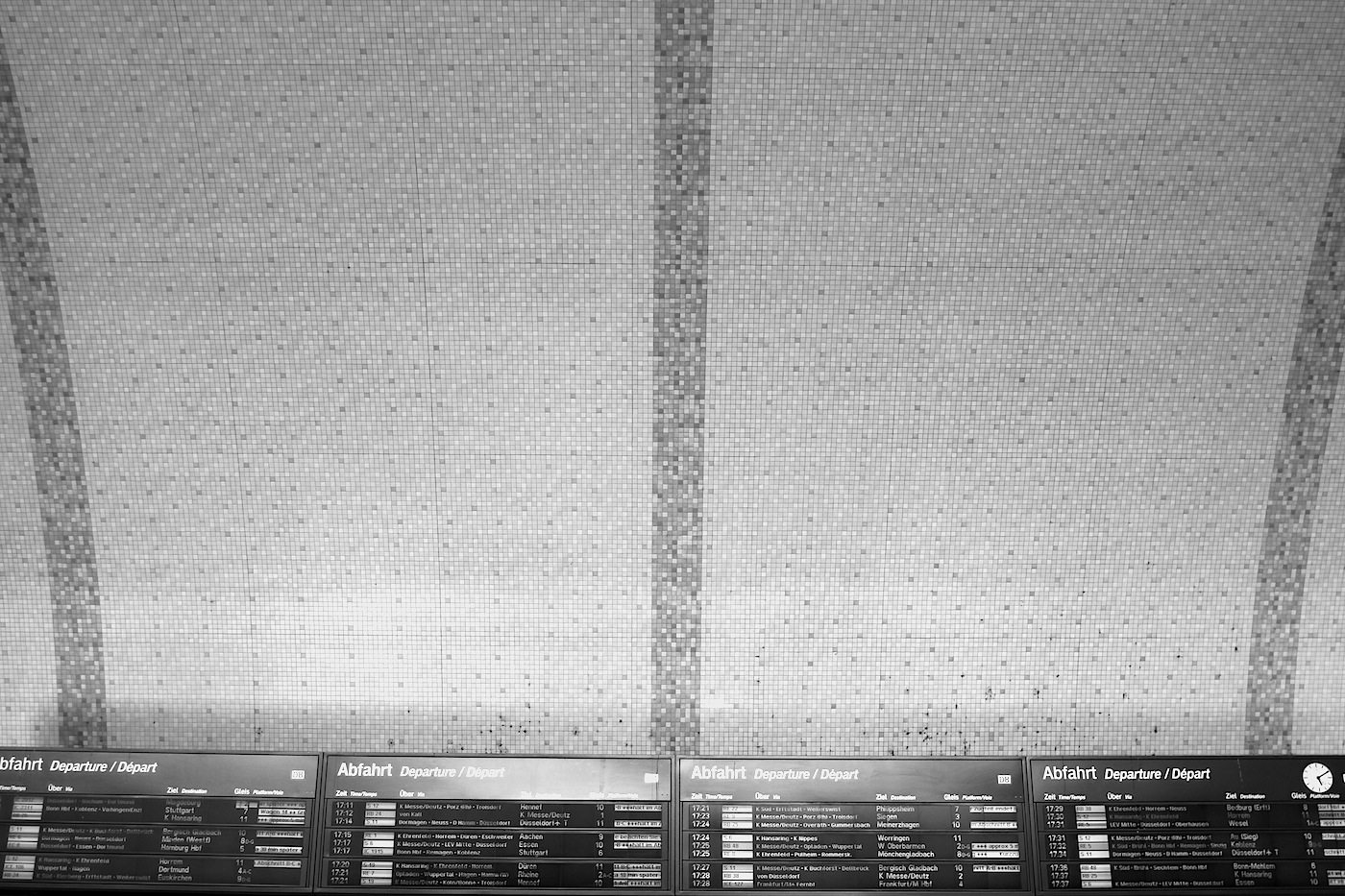
Cologne Central Station
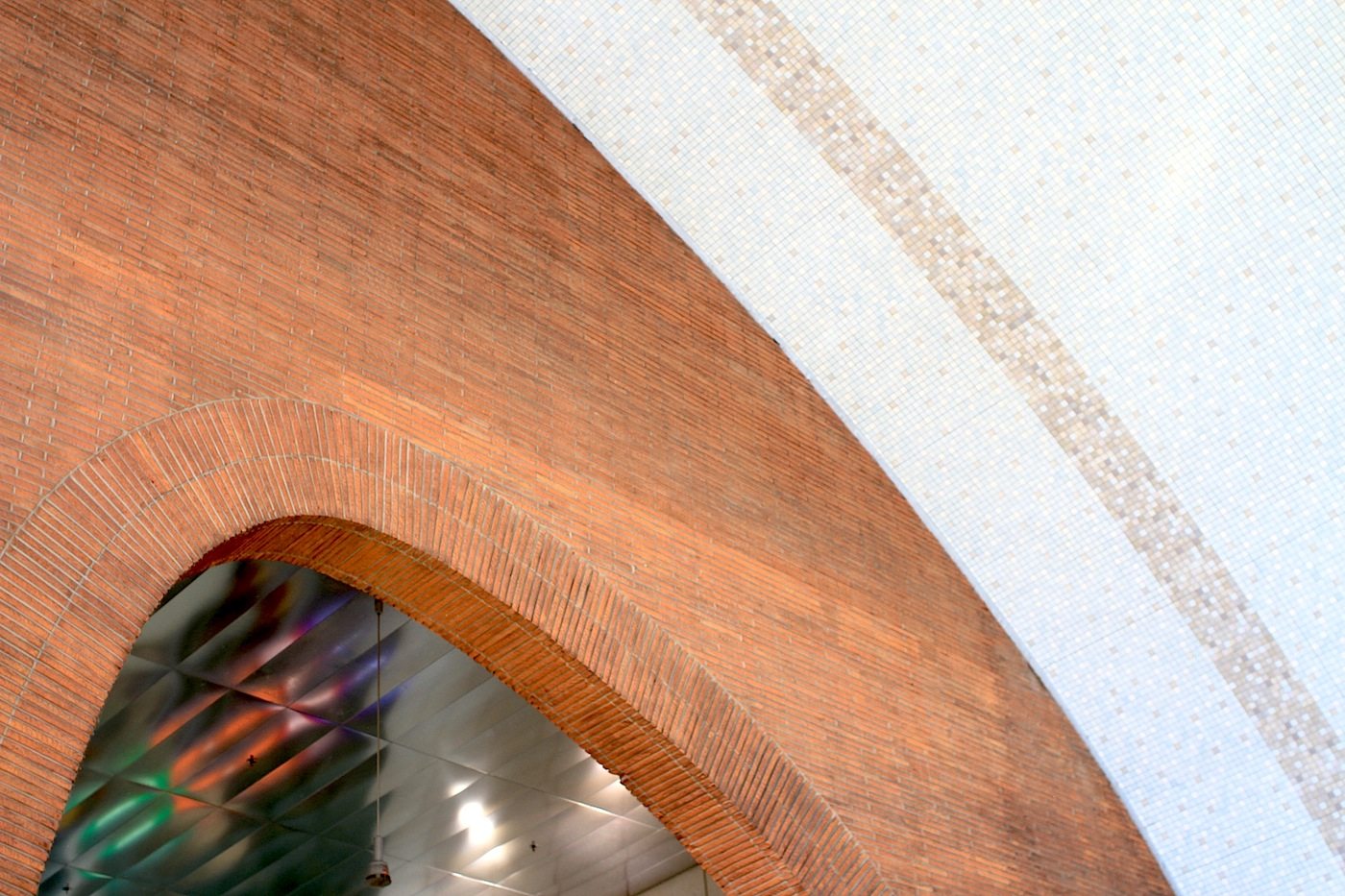
Cologne Central Station
shell-shaped roof ...
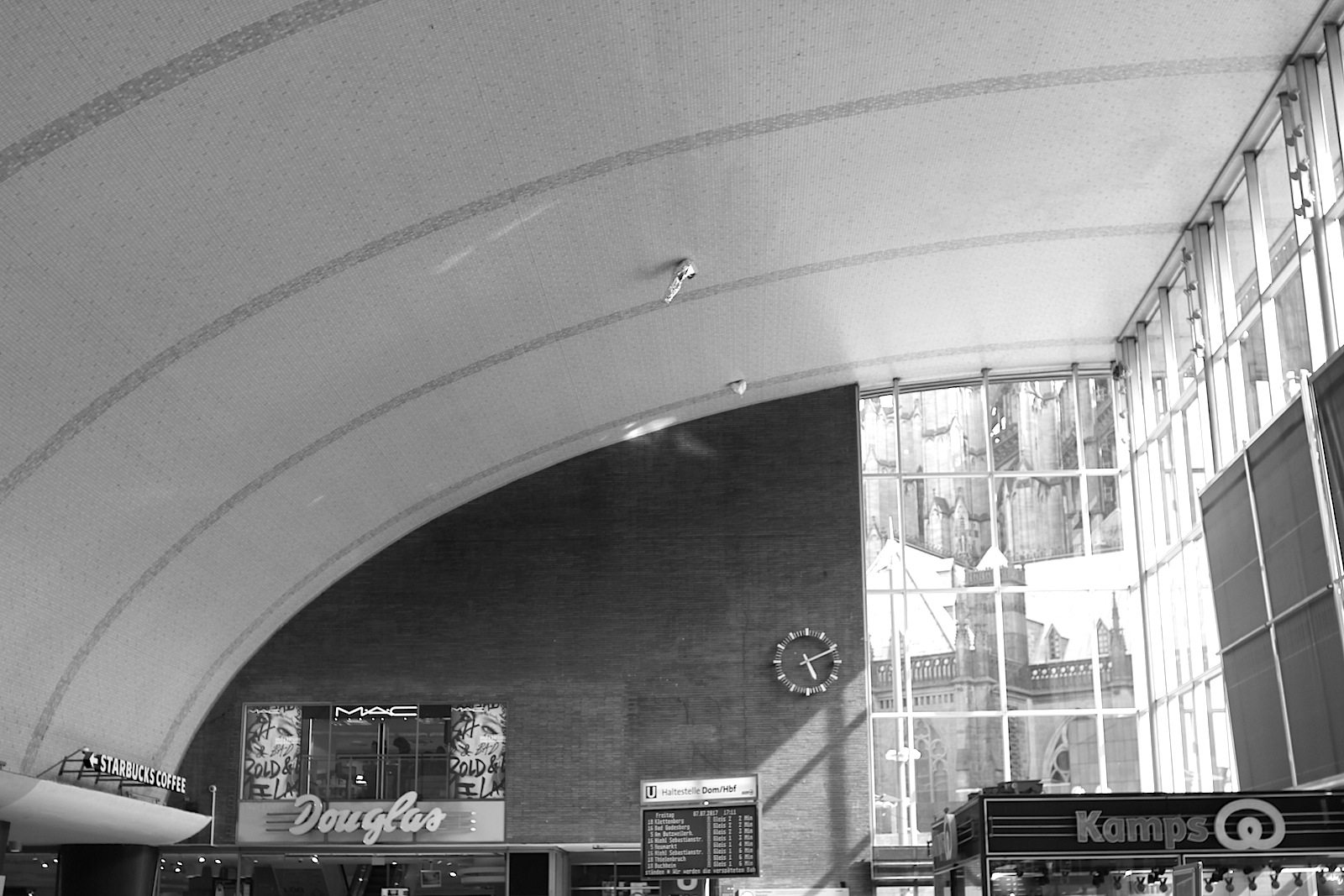
Cologne Central Station
... to the design of the architects Schmitt and Schneider.
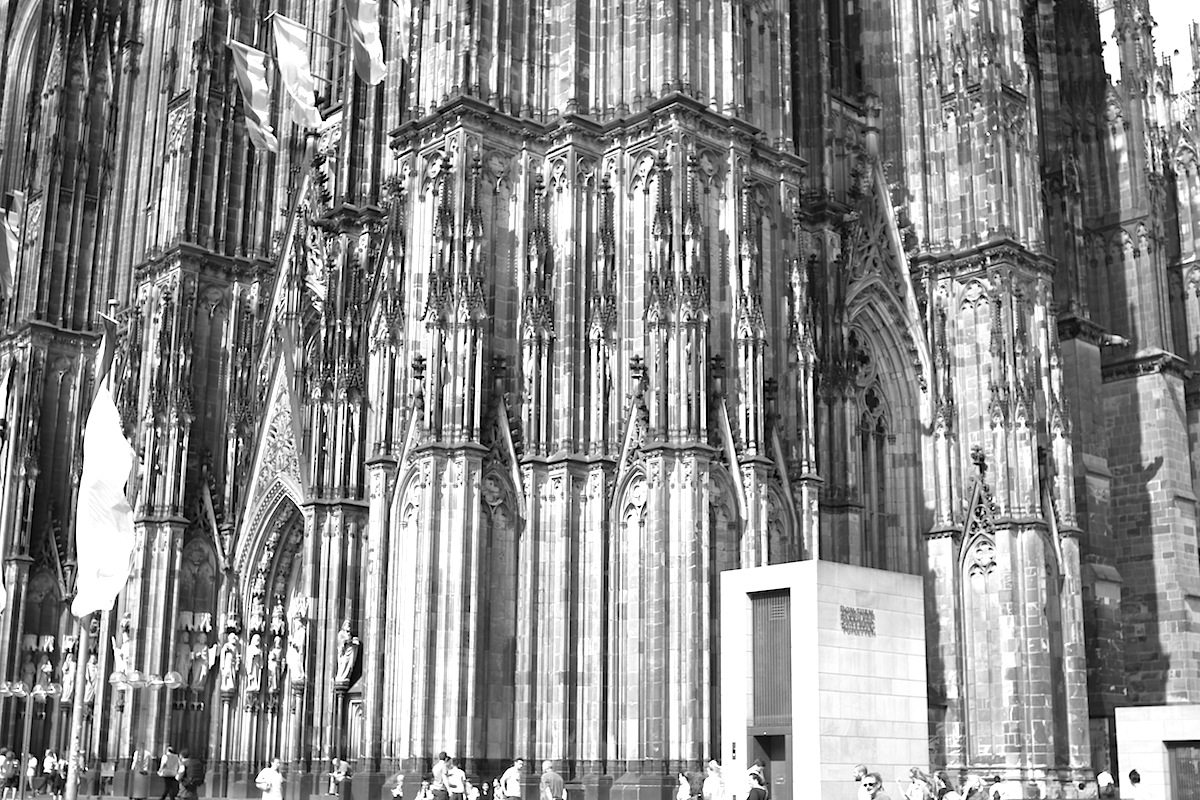
New Construction of an Access Building to the South Tower, 2009
Minimalist-cubist pavilion architecture at the cathedral.
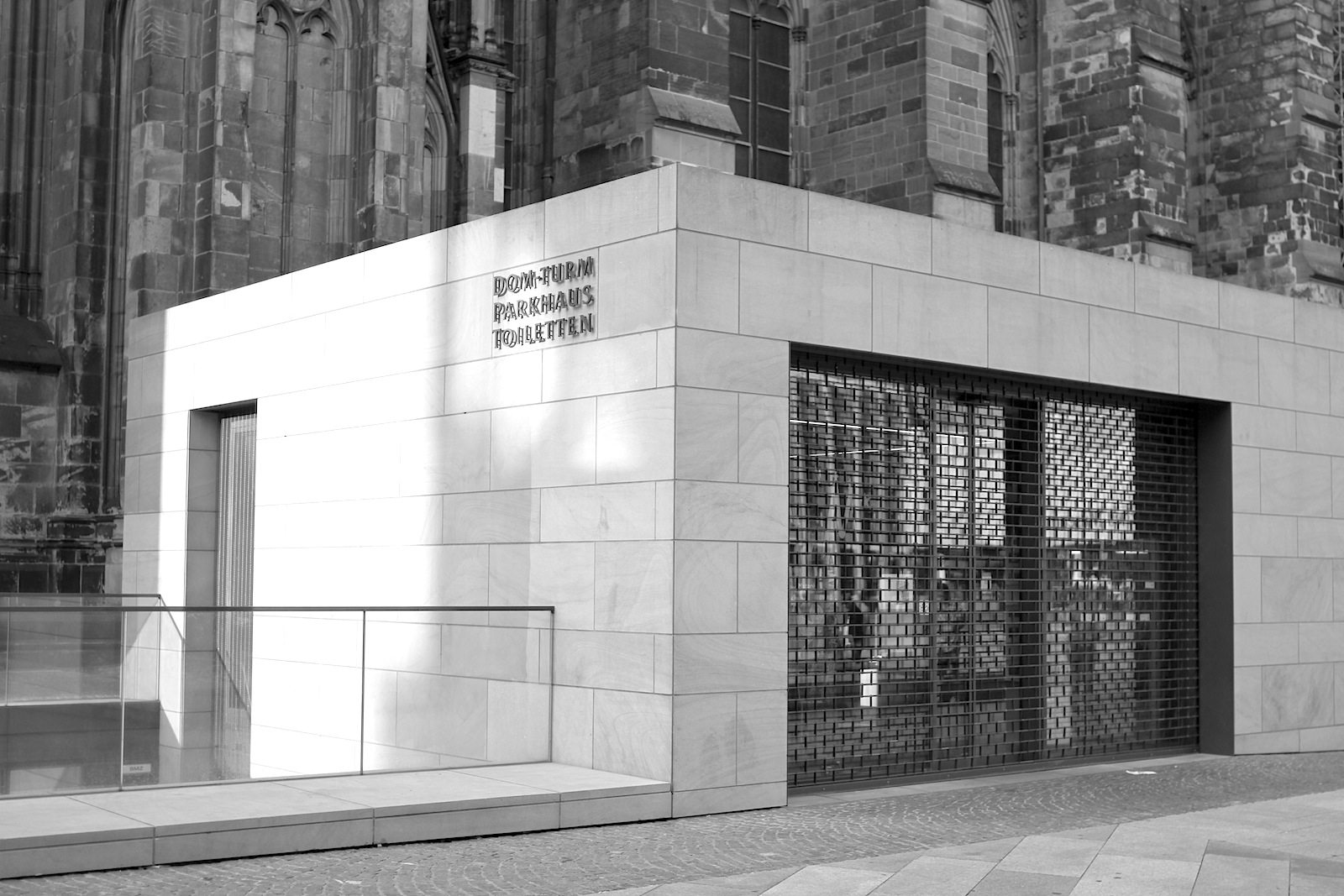
New Construction of an Access Building to the South Tower, 2009
by the architect Kasper Krämer, Cologne.
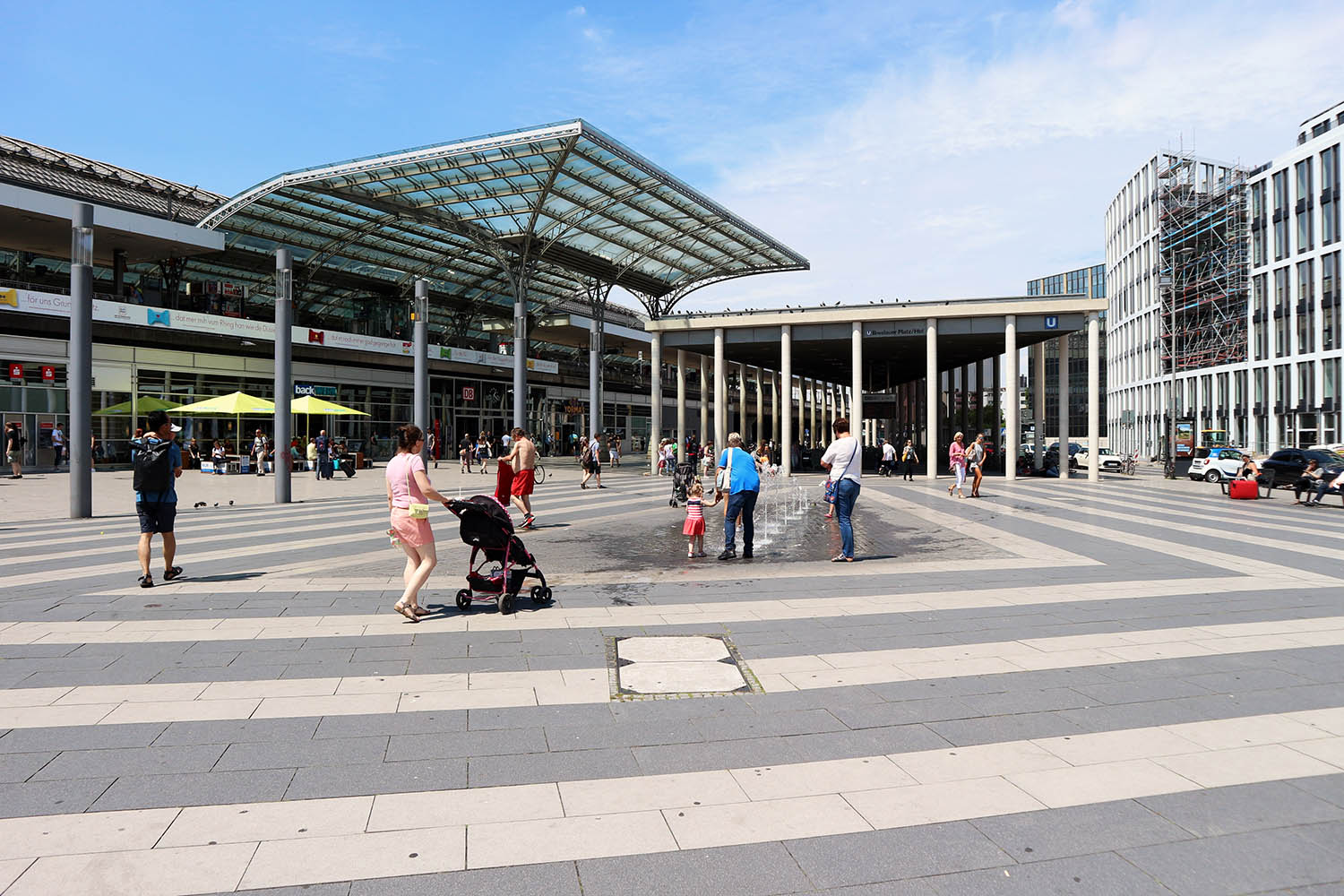
Breslauer Platz, Completion of the New Design, 2013
Designed by Büder + Metzel Architekten, Brühl/Cologne. Breslauer Platz is a square on the northeast side of the central train station. The transformation into an urban space took some time. The work done by Kai Büder and Manfred Metzel resulted in greater transparency and a clearly designed, public space with more room for pedestrians. Under each of the three column-supported pavilion roofs of the station, a weather-protected extension of the front plaza areas has arisen, as an entrance to the subway station and to the central train station.
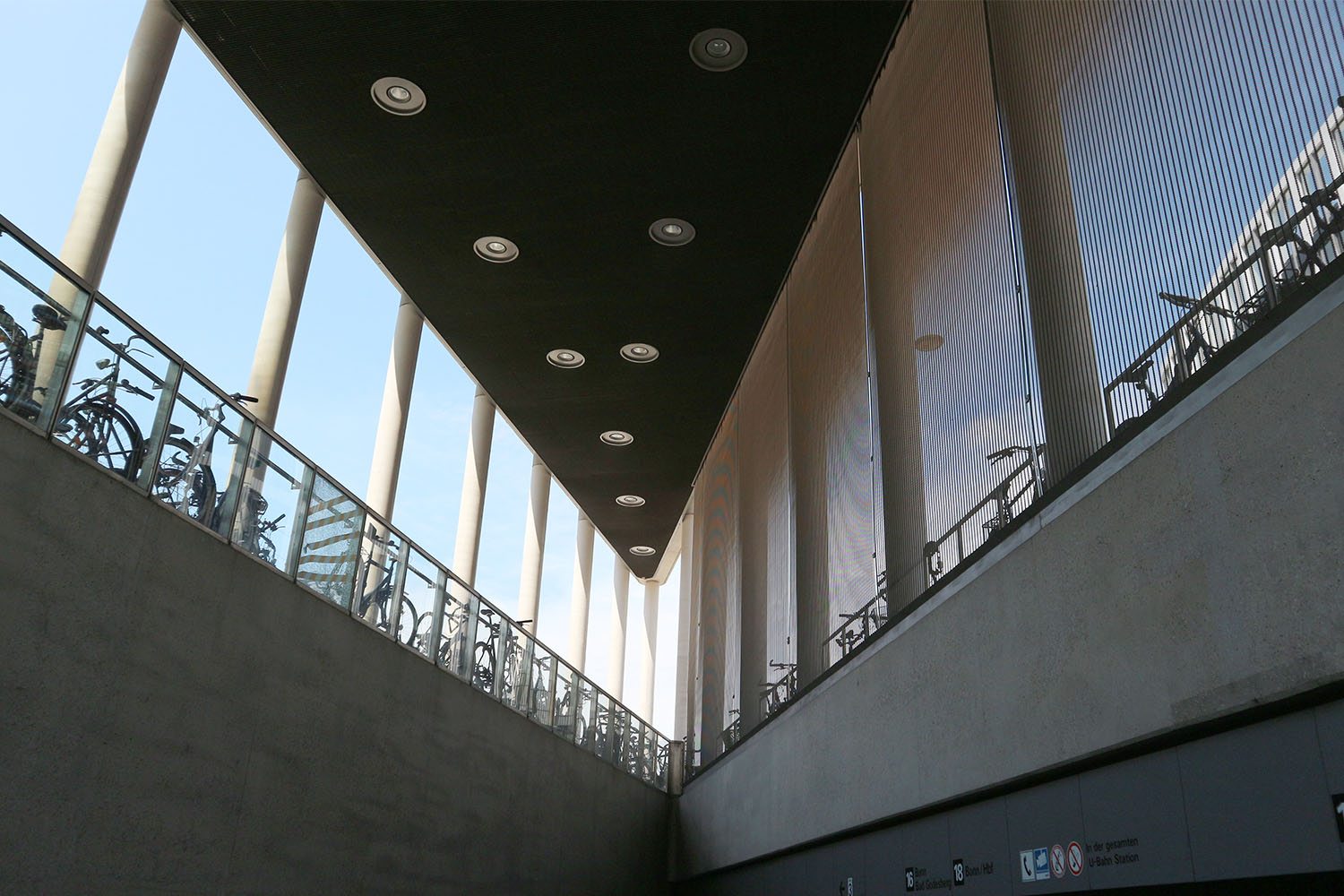
Breslauer Platz Station, 2011
Designed by Büder + Mendel Architekten, Brühl/Cologne. The newly constructed urban square creates the entrée to the entrances of the central train station and the new underground rail station.
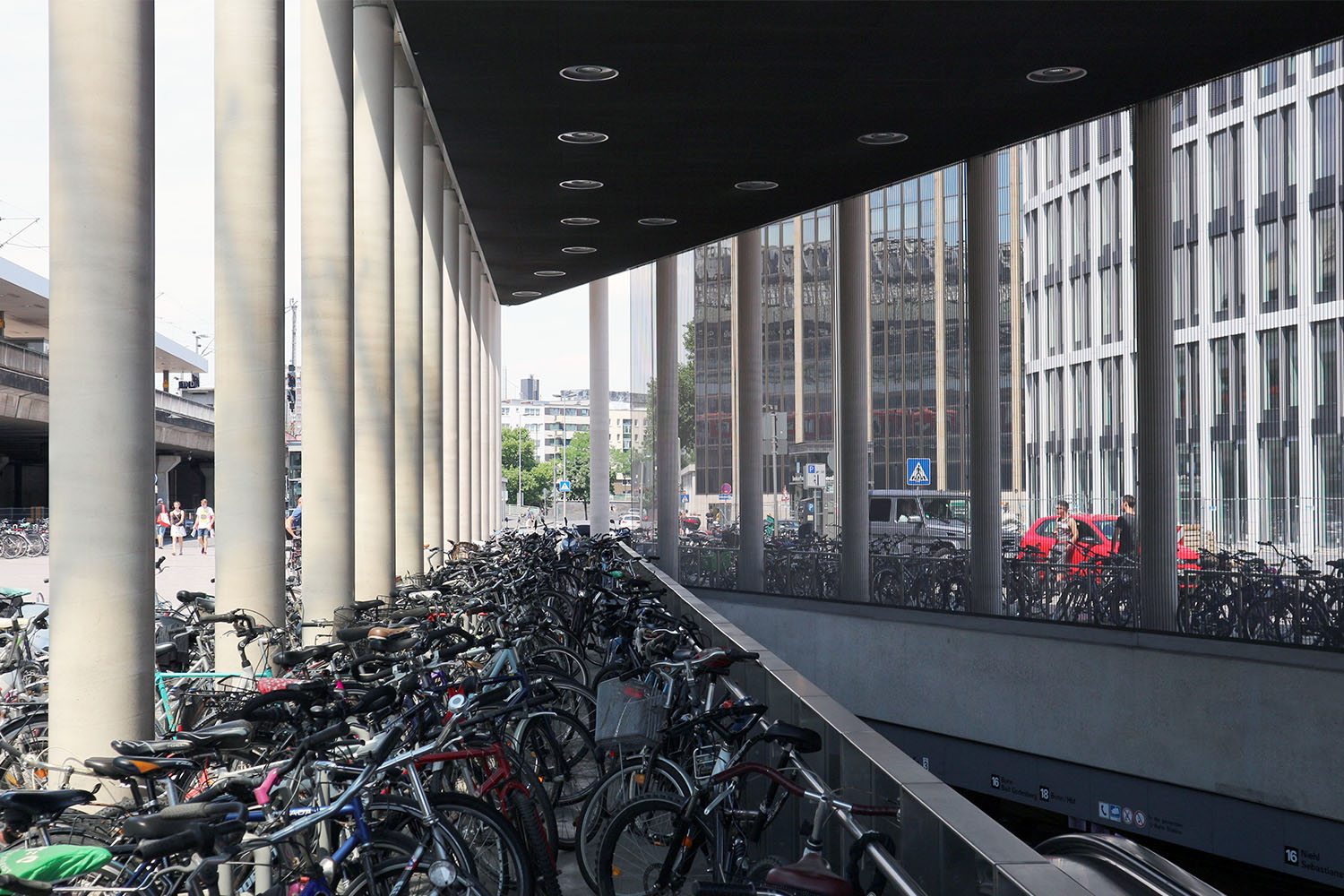
Breslauer Platz Station, 2011
The necessary connection of existing and new tracks created a train platform system, shifted lengthwise, with middle- and side platforms. The station is 225 metres long and 11.5 metres high. Daylight streams through the large openings of the entrances and the glass lift shafts.
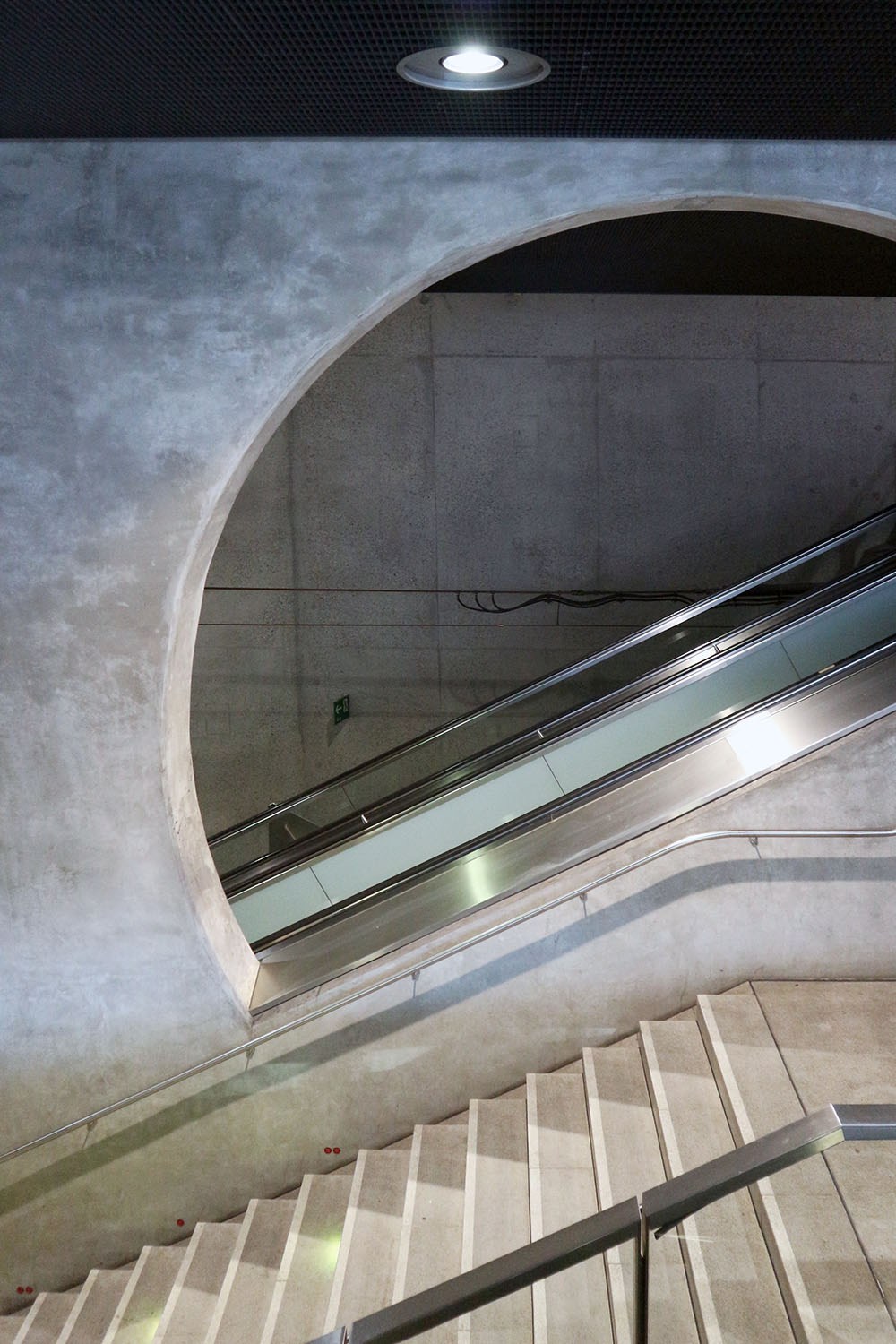
Breslauer Platz Station, 2011
The distribution level consists of two galleries across from one another, from which the entire interior space is directly visible.
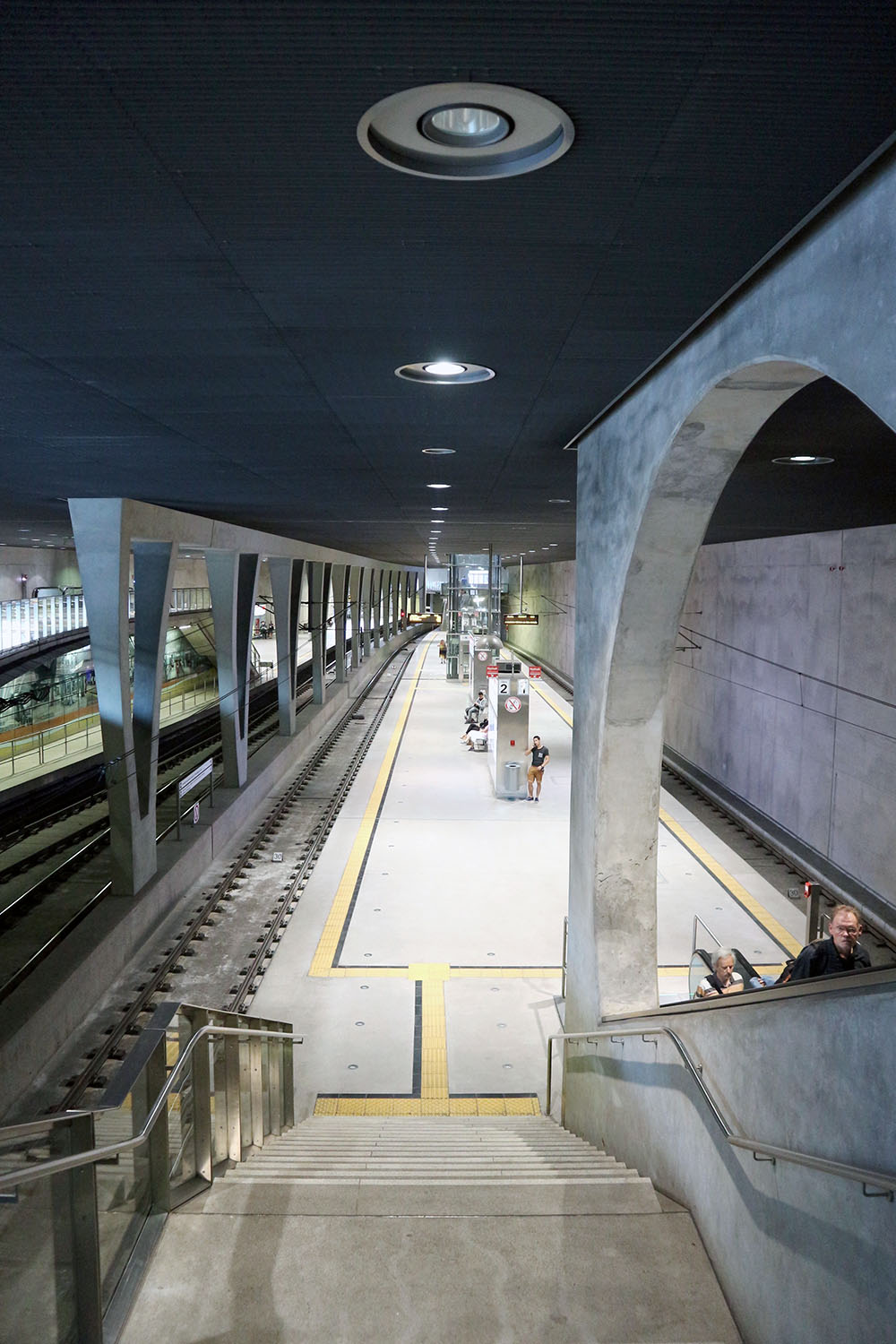
Breslauer Platz Station, 2011
Other features: the middle row of V-shaped supports, the glass lifts and escalators as well as both galleries with glass railings.
MediaPark: Multi and More Cologne
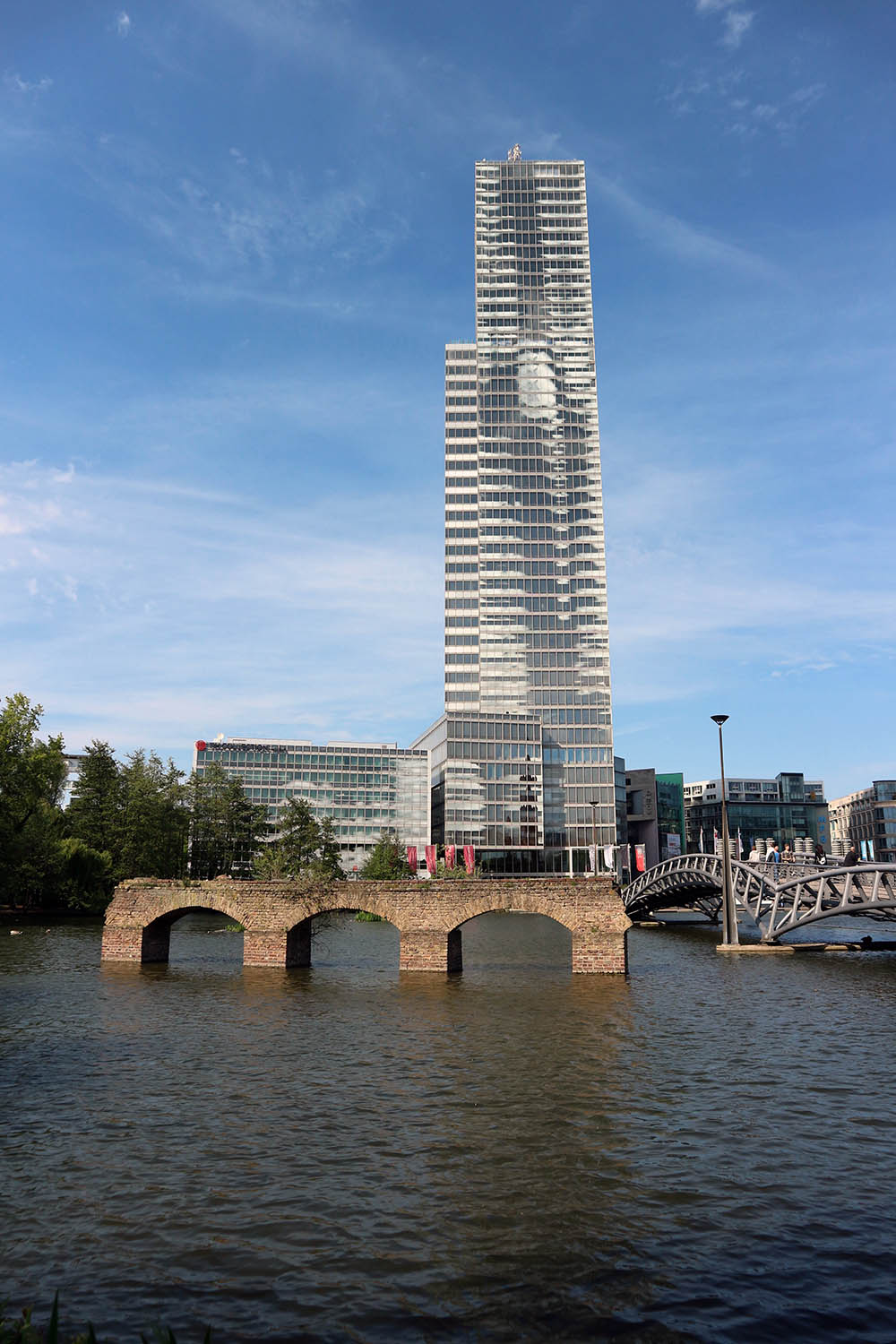
Cologne Tower
It was set up to accommodate companies of the media and communication industry, as well as cultural institutions, a hotel and some apartment buildings. The MediaPark is situated in Neustadt-Nord, Cologne, on the site of a former goods station, and is some 20 hectare large. The photo shows the lake and the KölnTurm by Jean Nouvel.
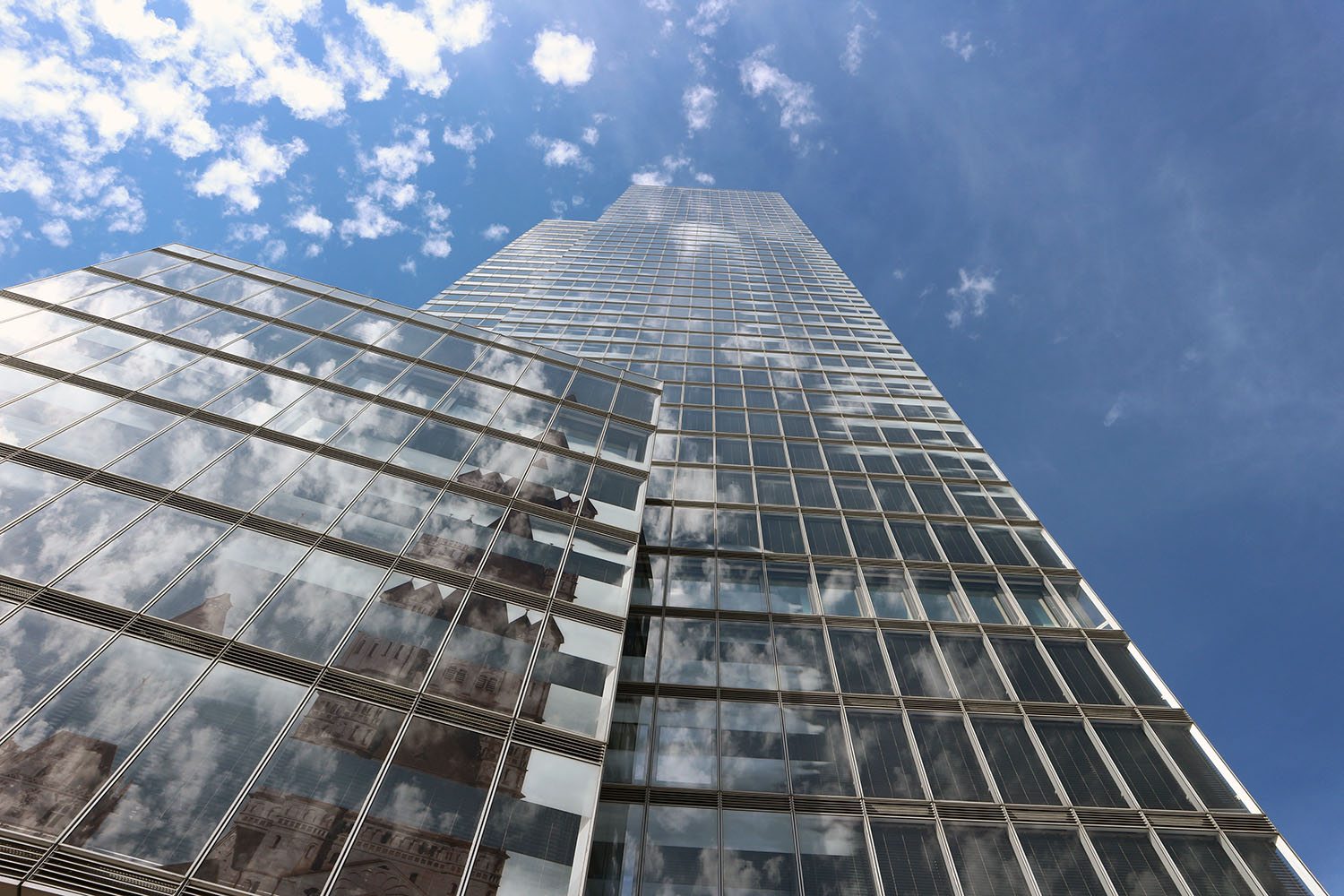
Cologne Tower
The project was designed by Canadian architect Eberhard Zeidler, with construction lasting from 1990 until 2004. The buildings sit radially around a central square, and are surrounded by parks and a small lake. The city quarter's focal point is the 148 metre tall KölnTurm, designed by French architect Jean Nouvel and completed in 2001.
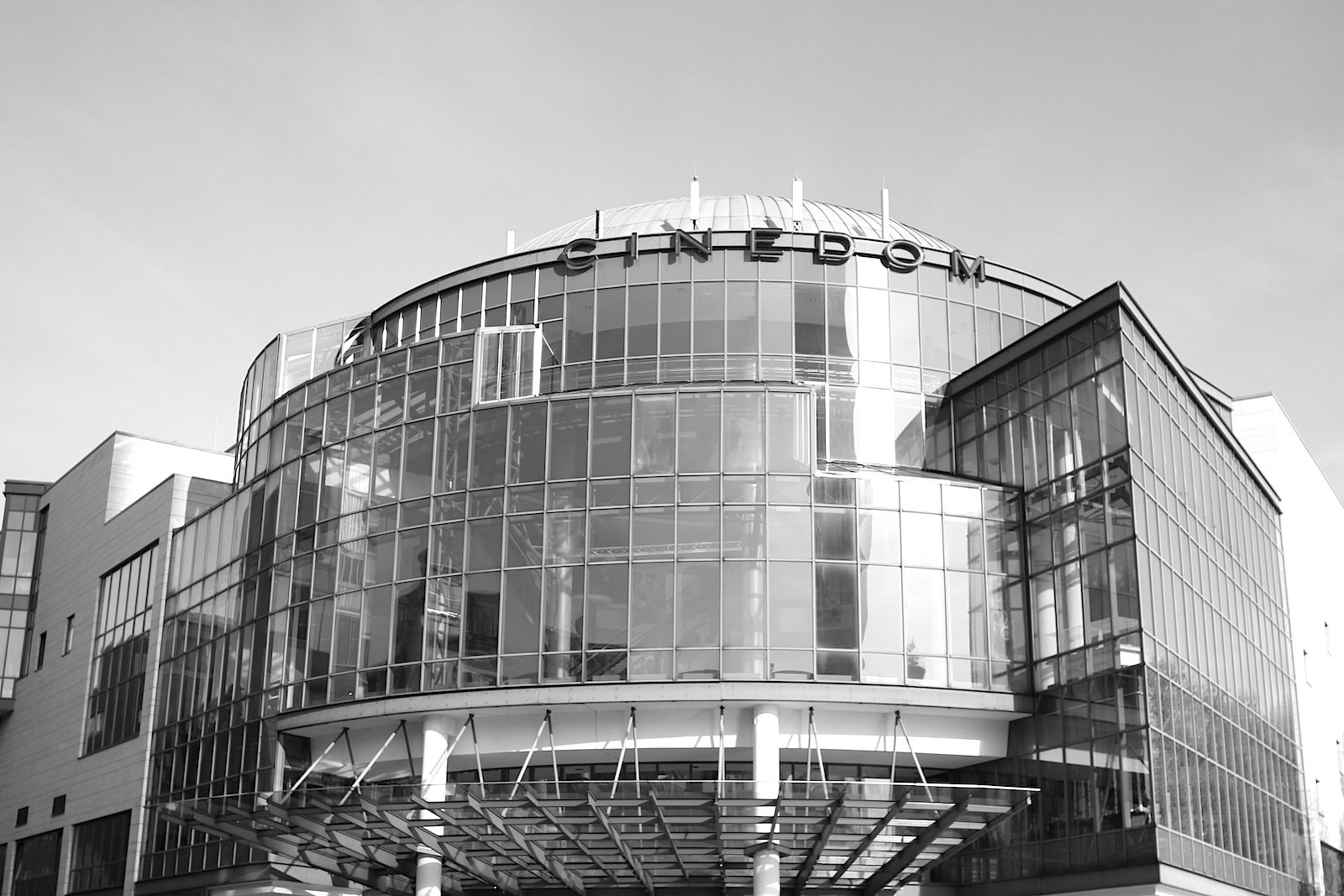
Cinedom, 1990/1991
The glass rotunda of the multiplex cinema was designed by Zeidler Partnership Architects.
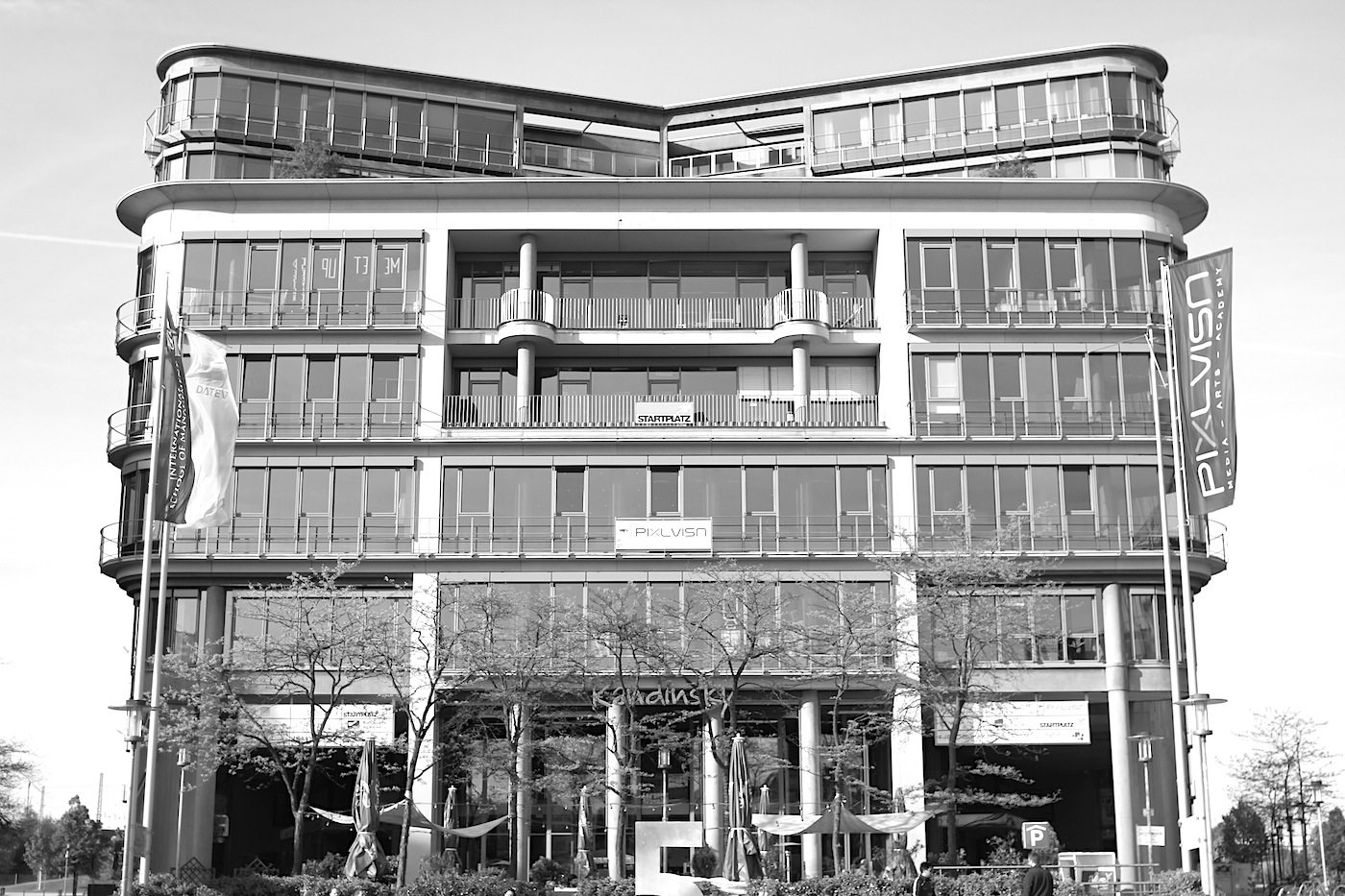
Im MediaPark 5, 1994
The architect Miroslav Volf, Cologne, arranged the ensemble with trapezoid-shaped block of buildings around a semicircular square.
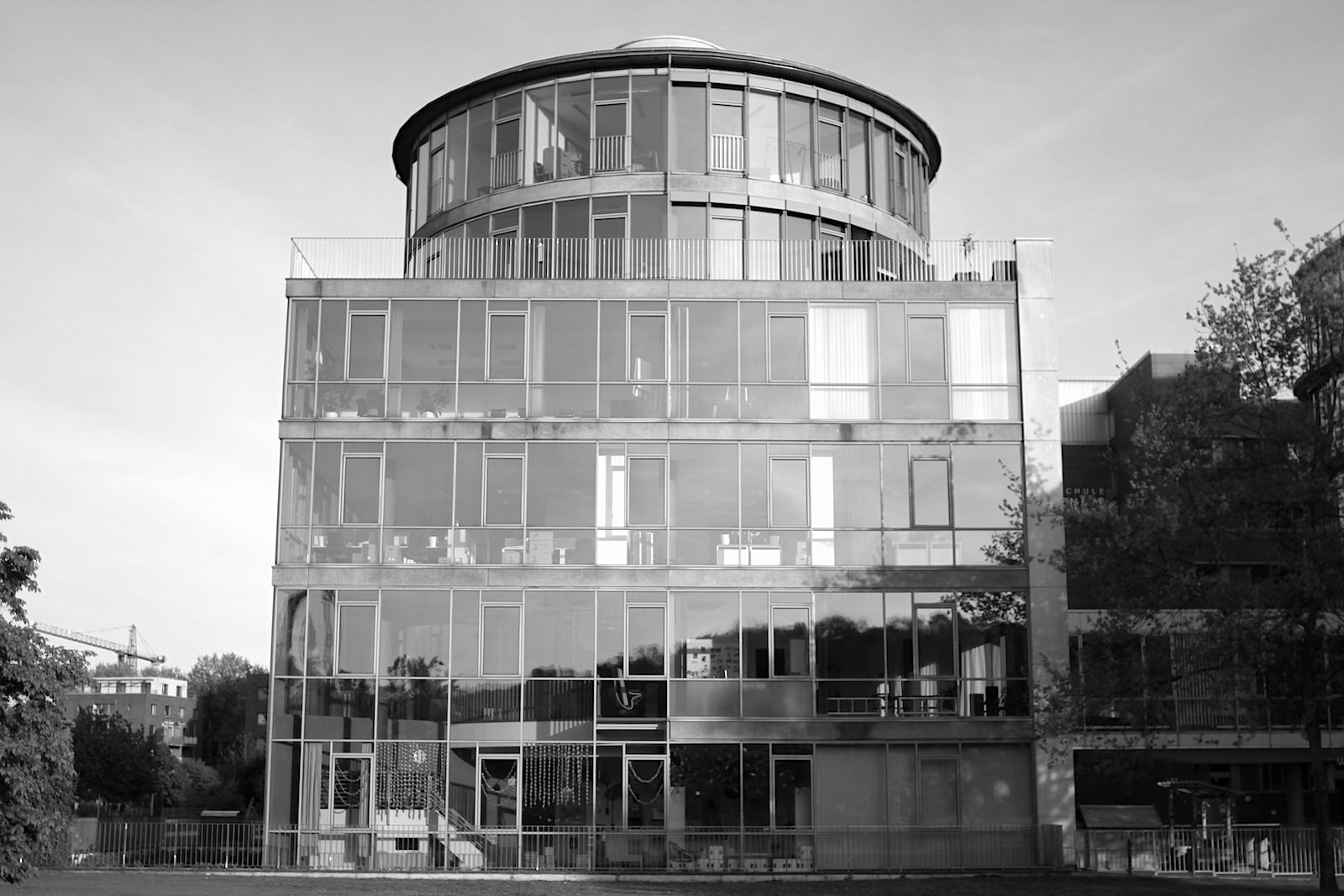
Im MediaPark 5, 1994
Miroslav Volf
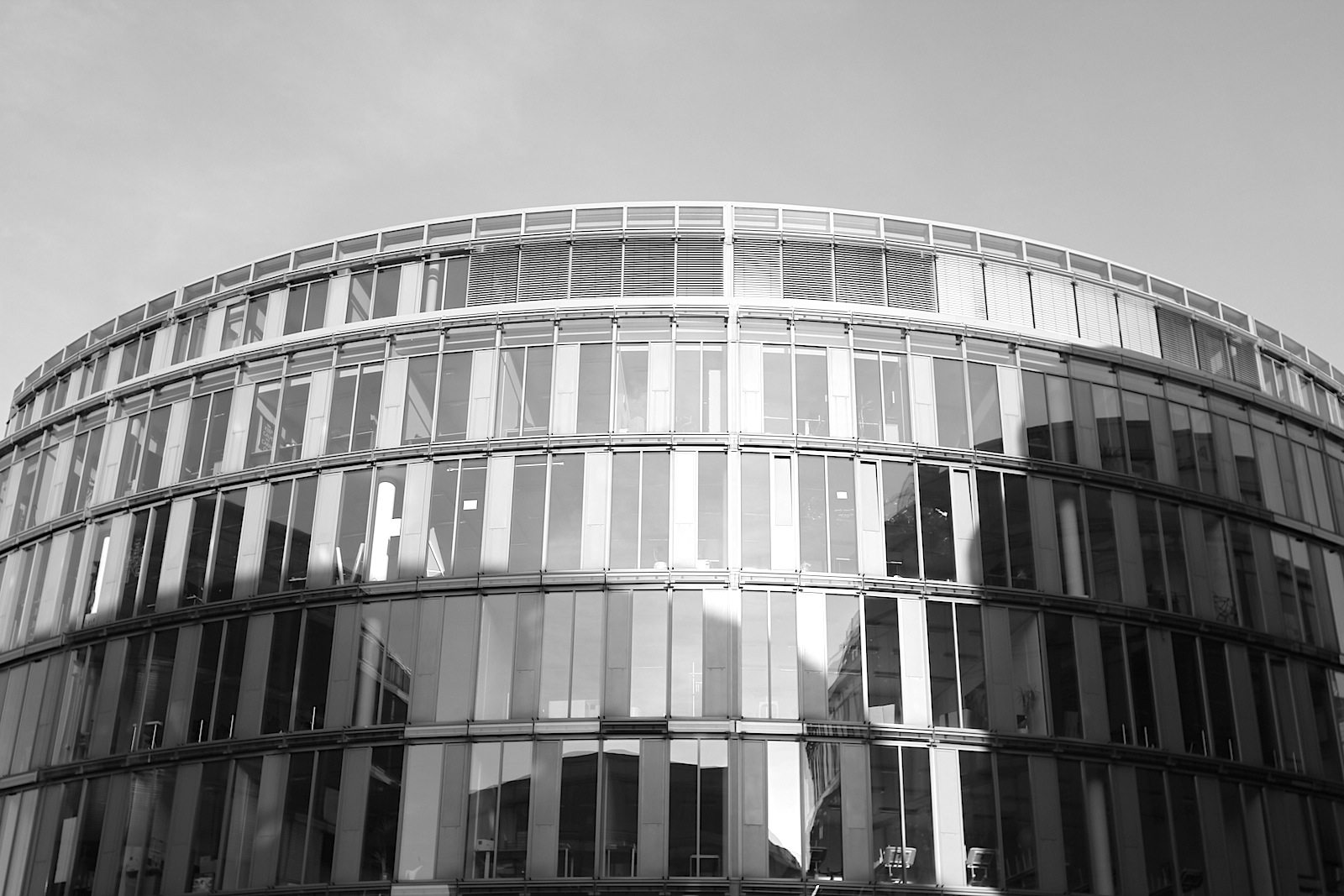
Im MediaPark 4 - Forum, 2003
Herman Hertzberger, Amsterdam. Instead of the perimeter block-form of the other slices, the design of the Forum divides the building into a quintet of segments grouped about a public courtyard.
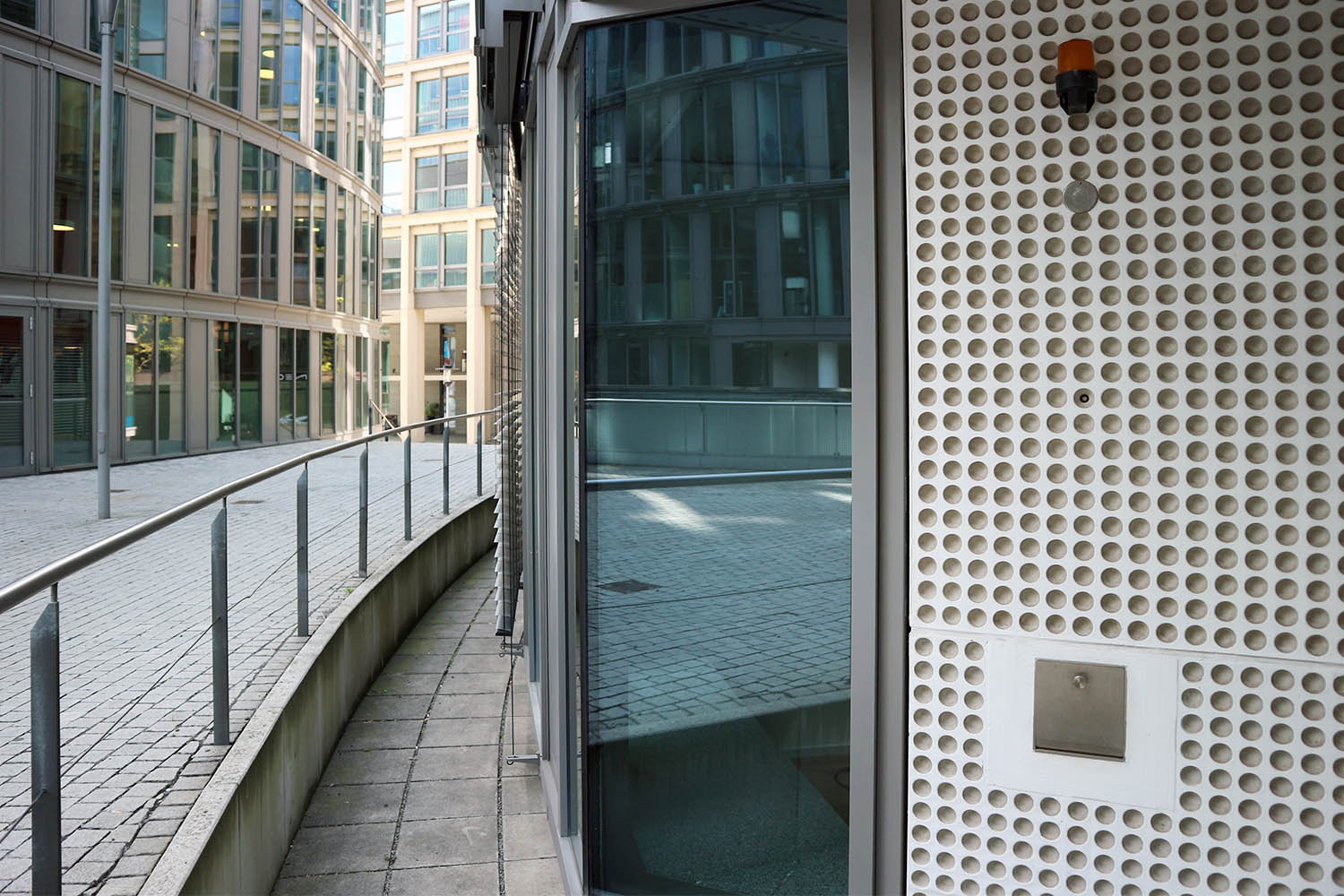
Im MediaPark 4 - Forum 2003
While the inner walls, inward-curving arcs taken from a single circle, are entirely of glass, the outward-facing 'sections' are more muted. All sides are consequently front facades, while the interior courtyard rejoins the public realm.
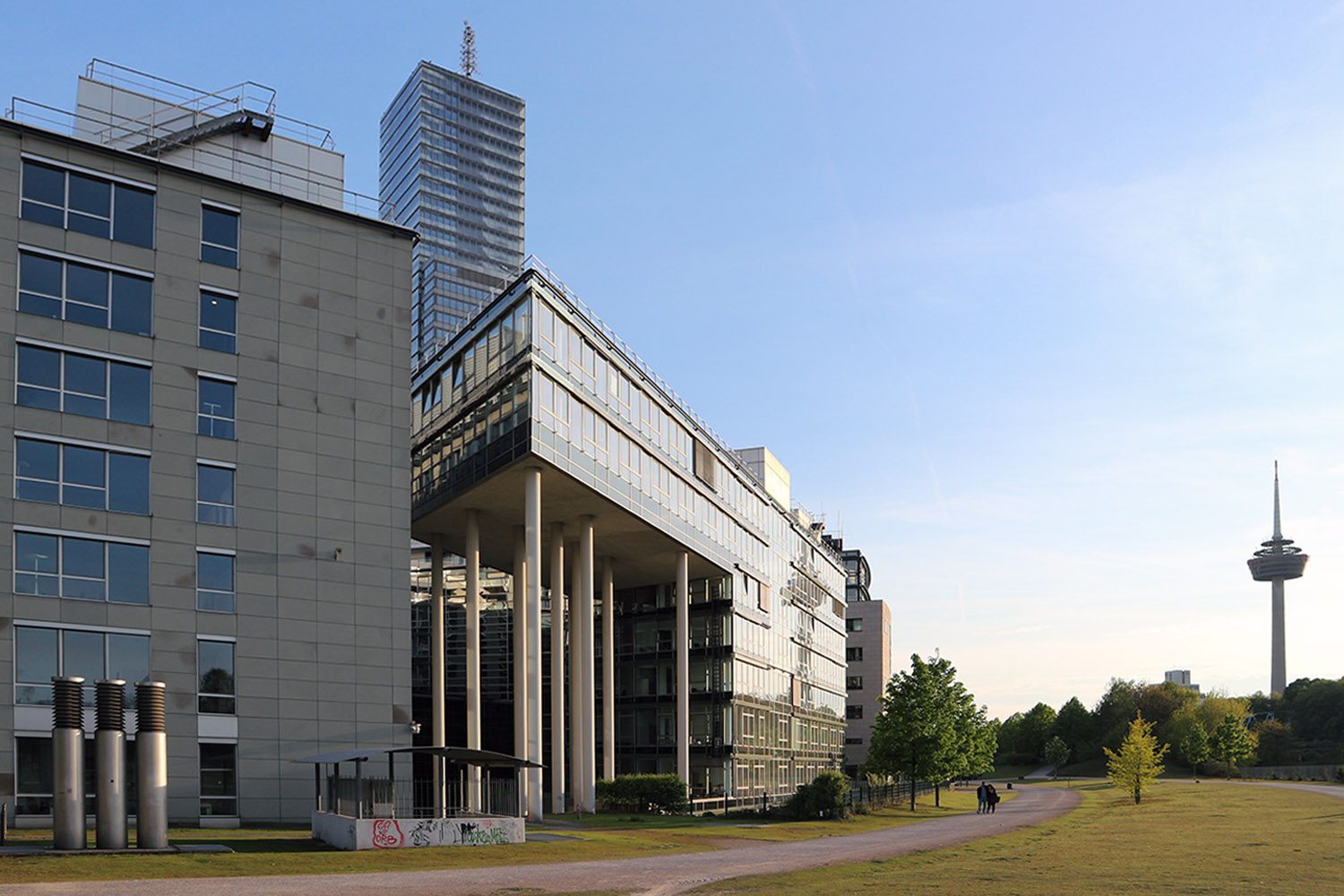
Im MediaPark 6, 2001
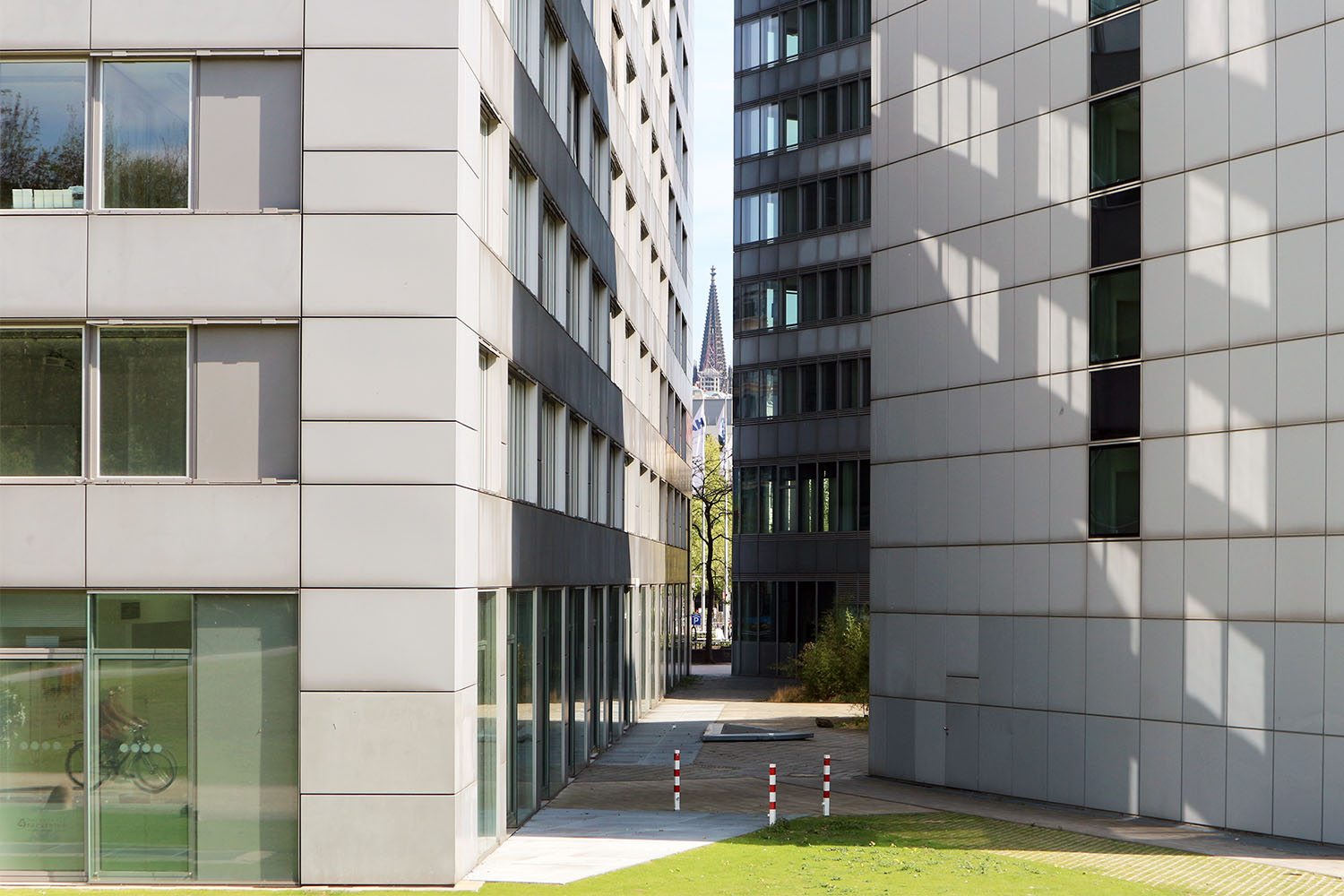
Im MediaPark 6, 2001
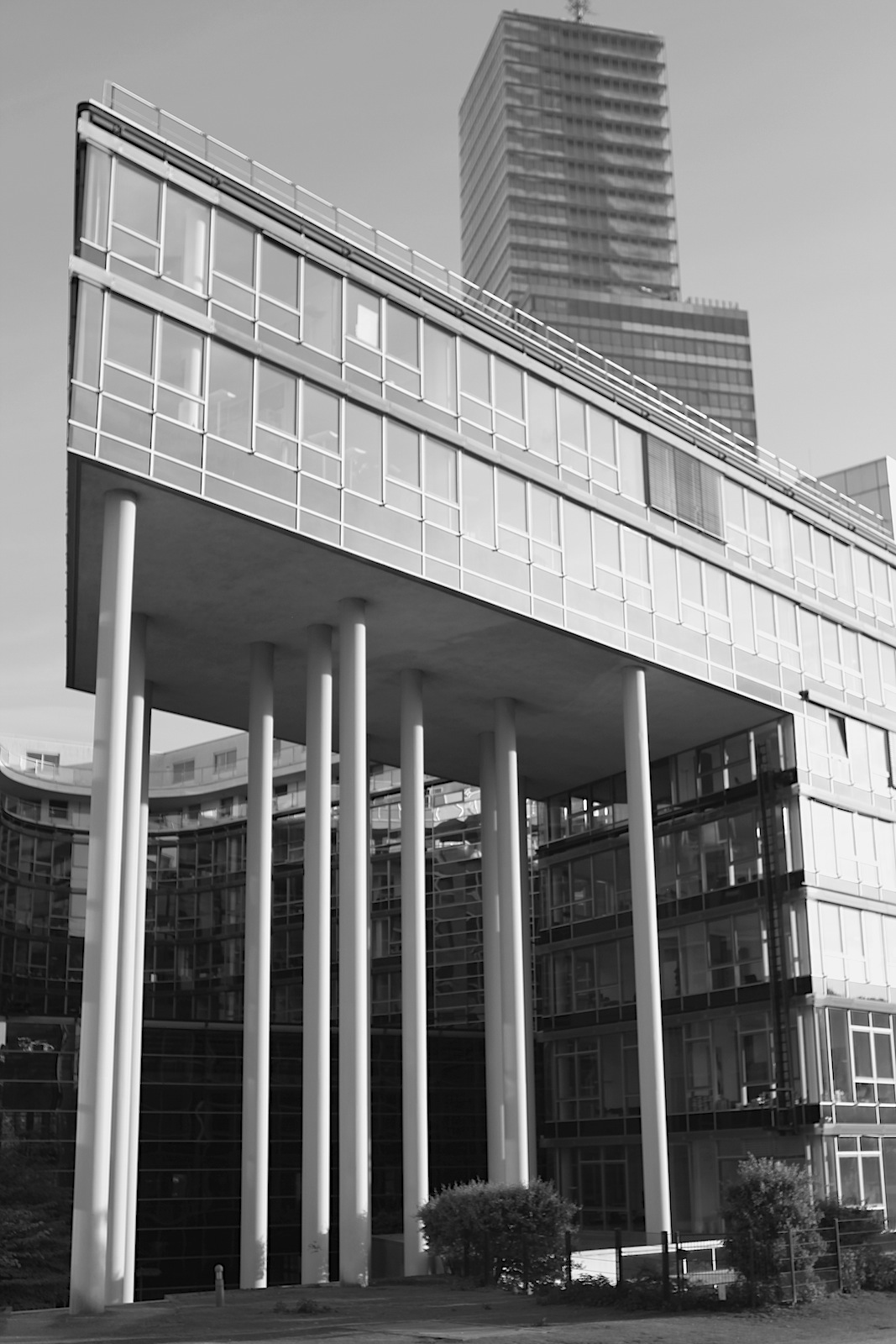
Im MediaPark 6, 2001
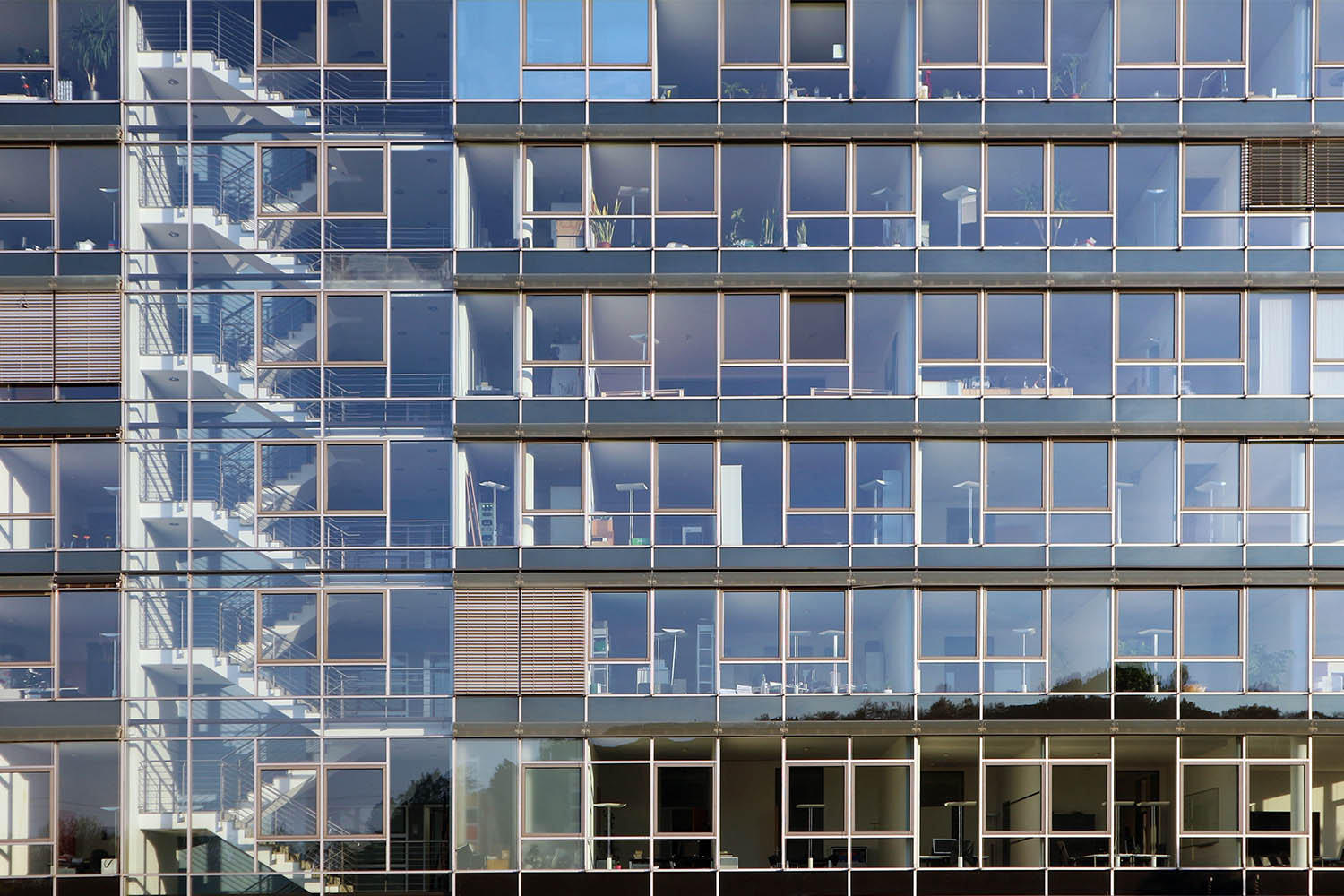
Im MediaPark 6, 2001

Im MediaPark 10, 1996
Steidle+Partner Architekten (now Steidle Architekten), Munich

Im MediaPark 16 - Transformer station
Architects: von Einsiedel, Cologne, Kraemer, Sieverts & Partner, Cologne
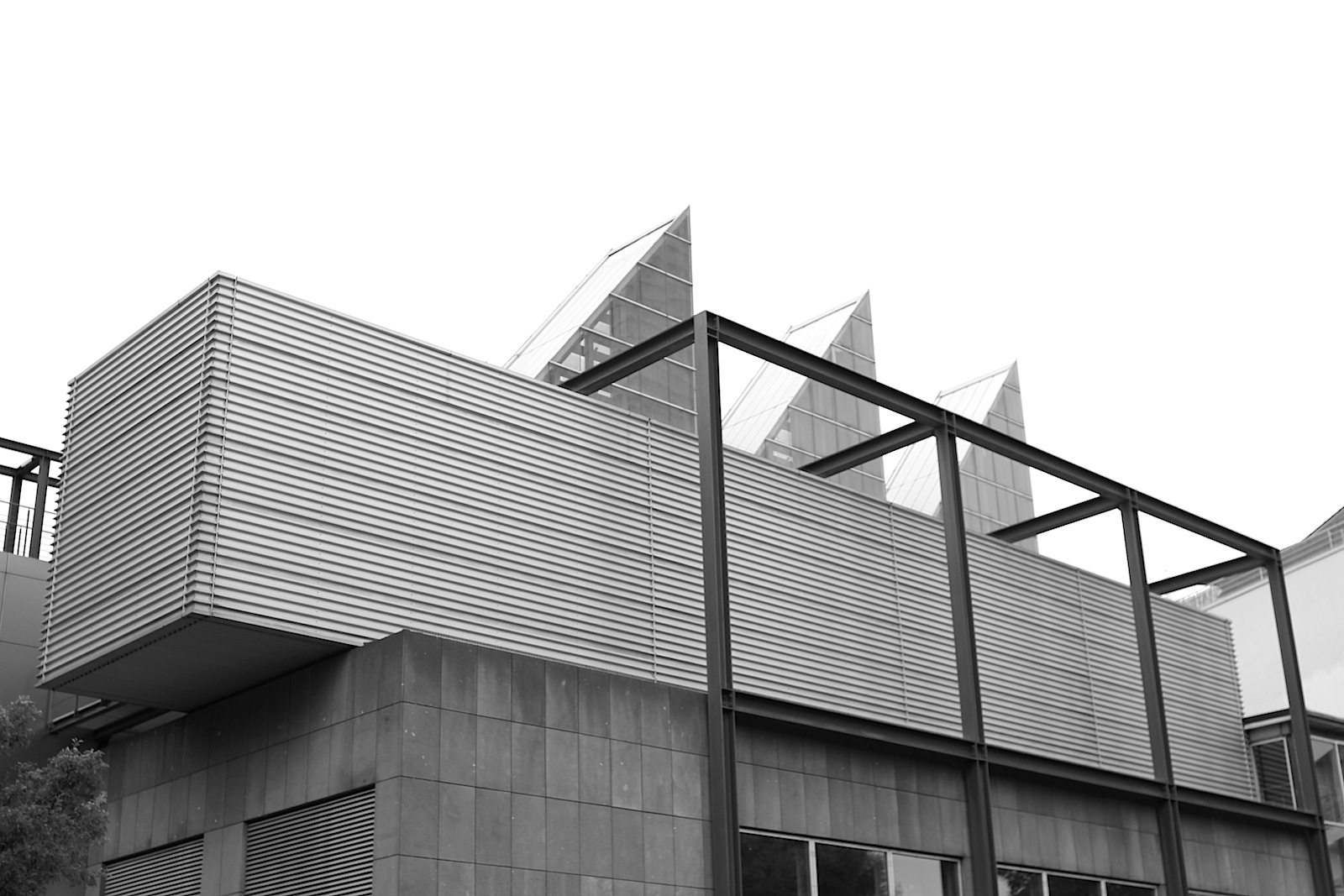
Im MediaPark 16 - Transformer station
Characteristic of the building’s appearance are the three transformer exhaust air cowls, which are visible from afar and resolve the structure at the top.
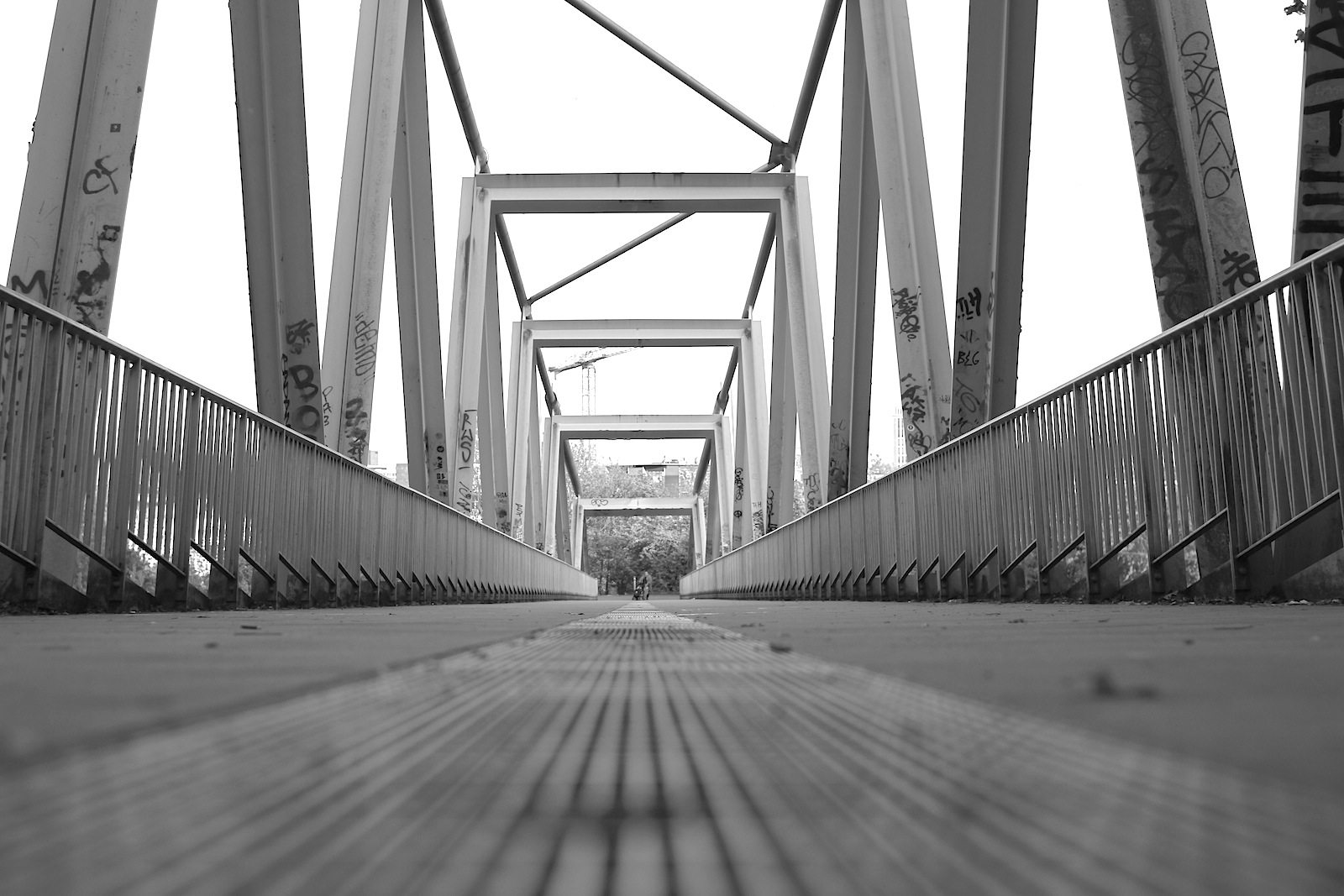
Pedestrian bridge
connecting the MediaPark with the Herkulesberg, one of the 11 rubble mountains in Cologne.
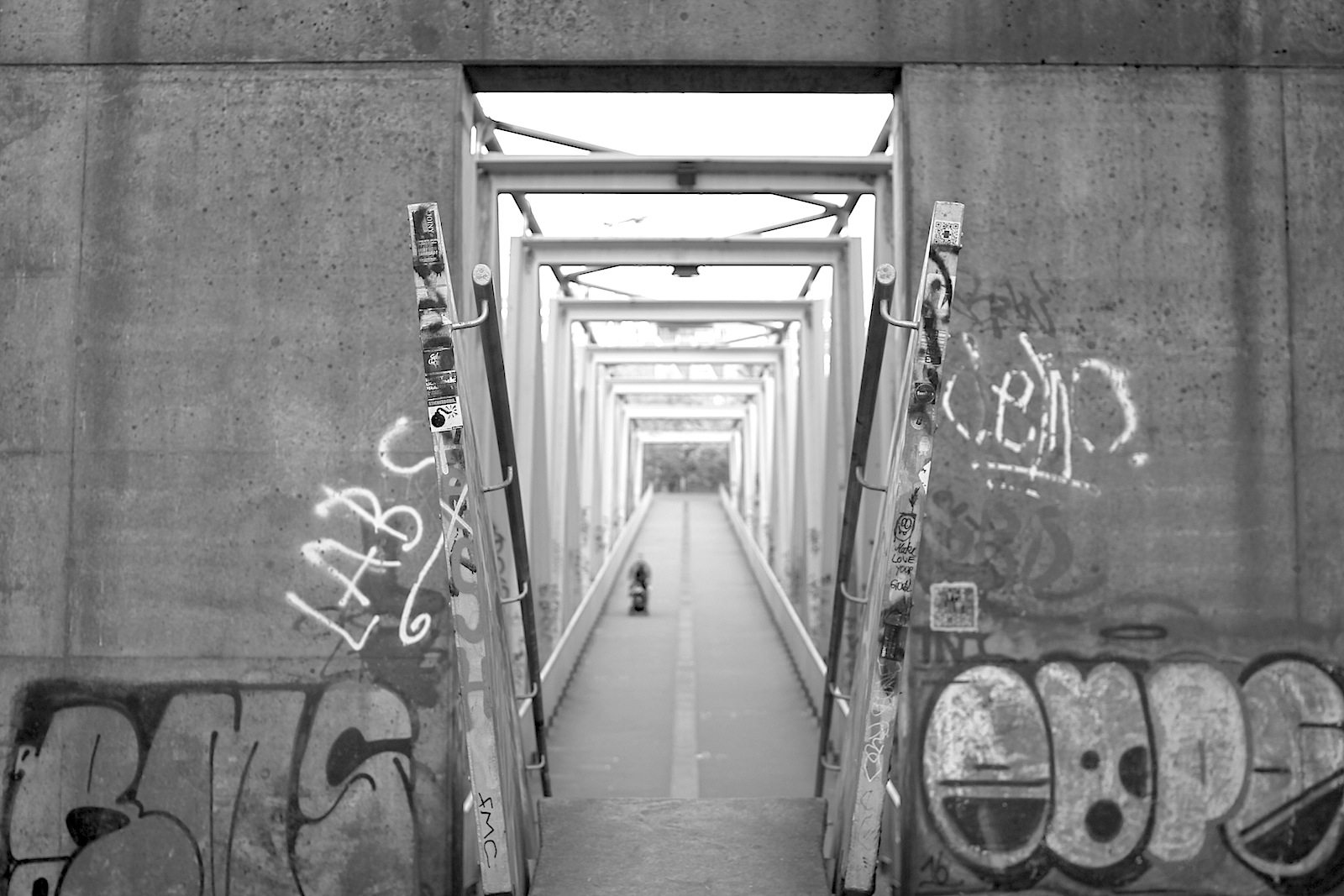
Pedestrian bridge
to the Herkulesberg, opposite to the MediaPark playground.
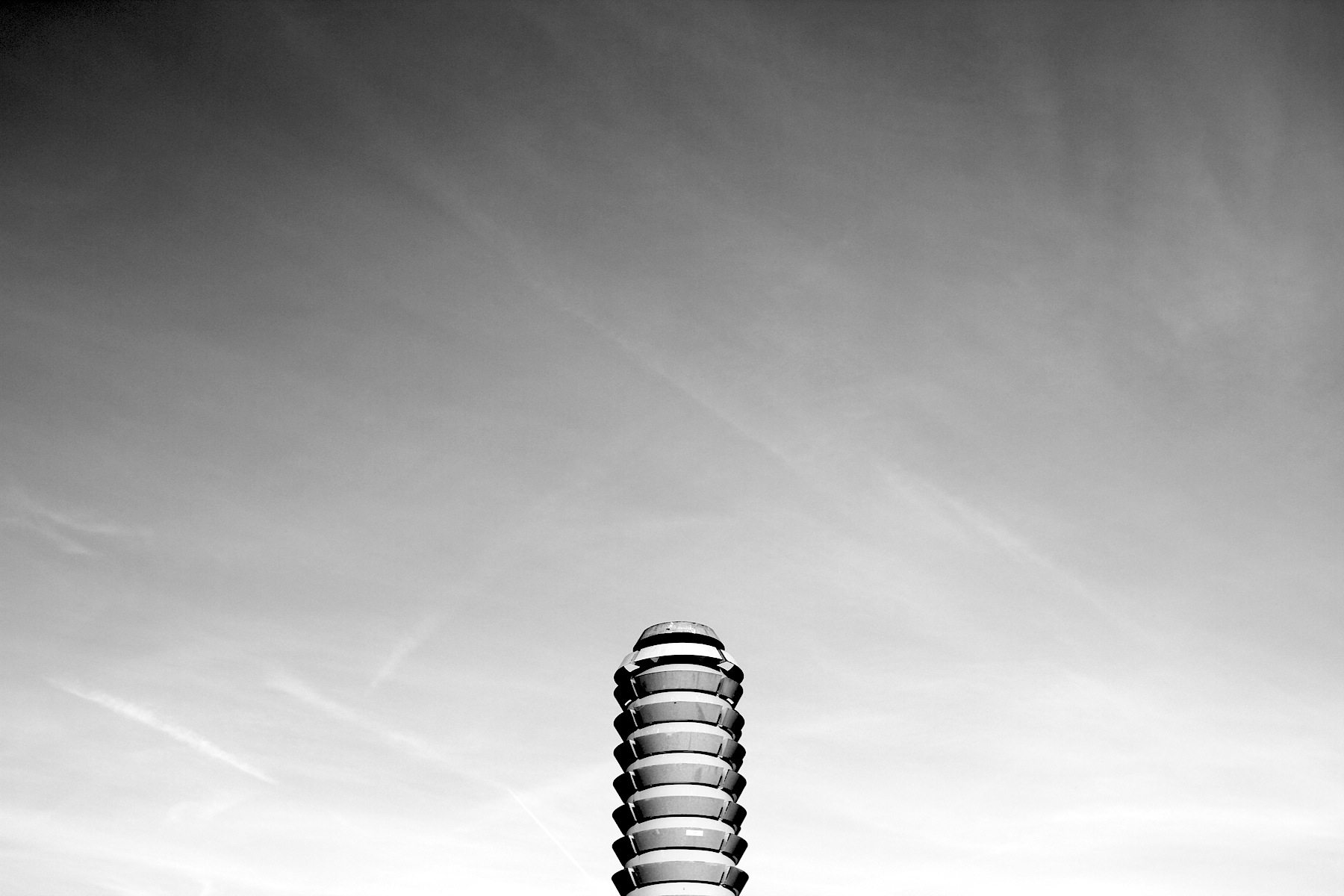
Ventilation
Landscape architect Jürgen Schubert (Cologne) designed the MediaPark lake, park, pedestrian bridge and shoreline.
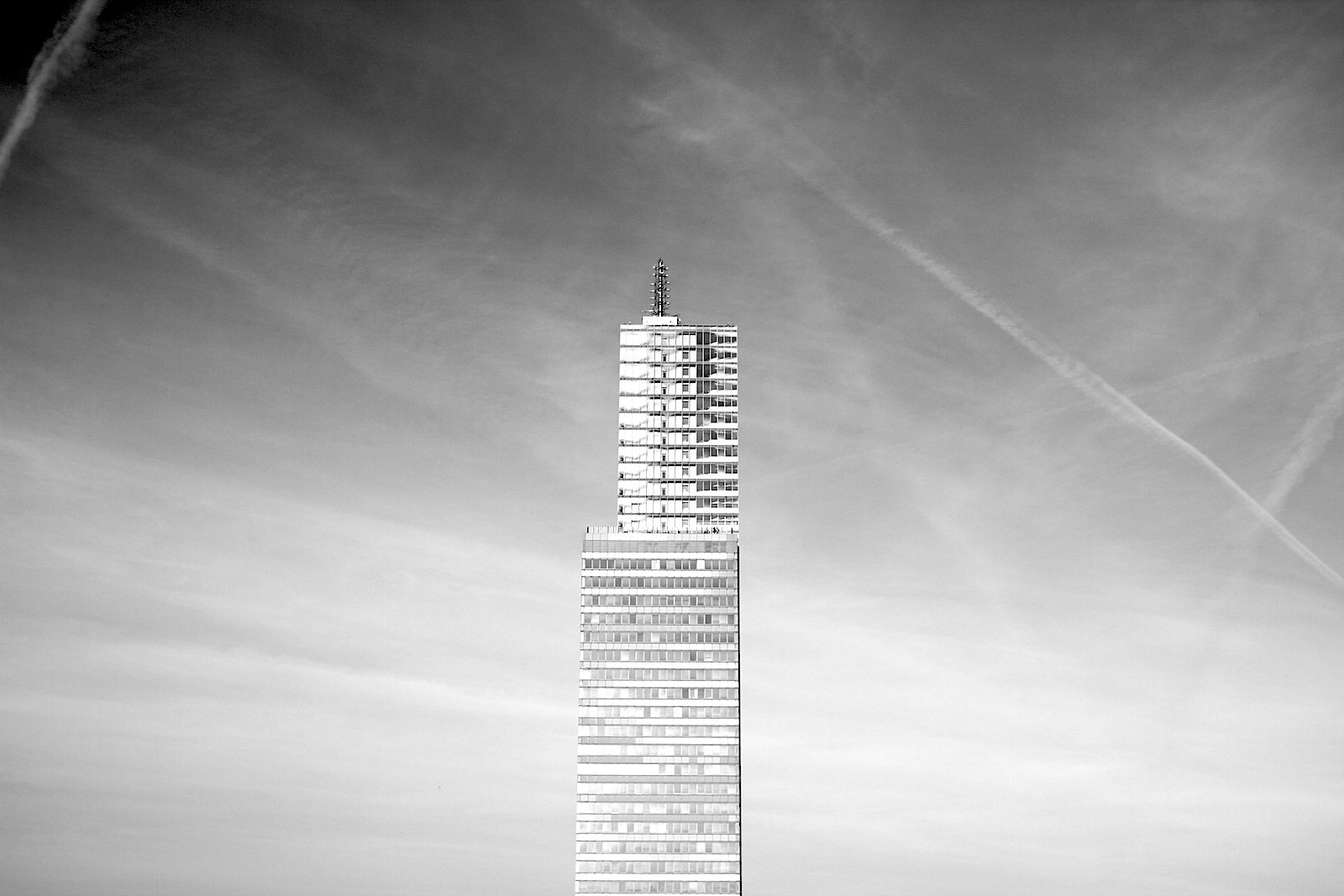
Cologne Tower
Reinforced concrete building. The glass facade of was designed with reflected light in mind. Pictures of the Cologne Cathedral and the skyline of Cologne's Old Town were applied to the glass via screen-printing. Depending on light exposure, different combinations of these images appear on the building. Design architect: Ateliers Jean Nouvel, associate architect: Georg Heckmann and Kohl und Kohl Architekten
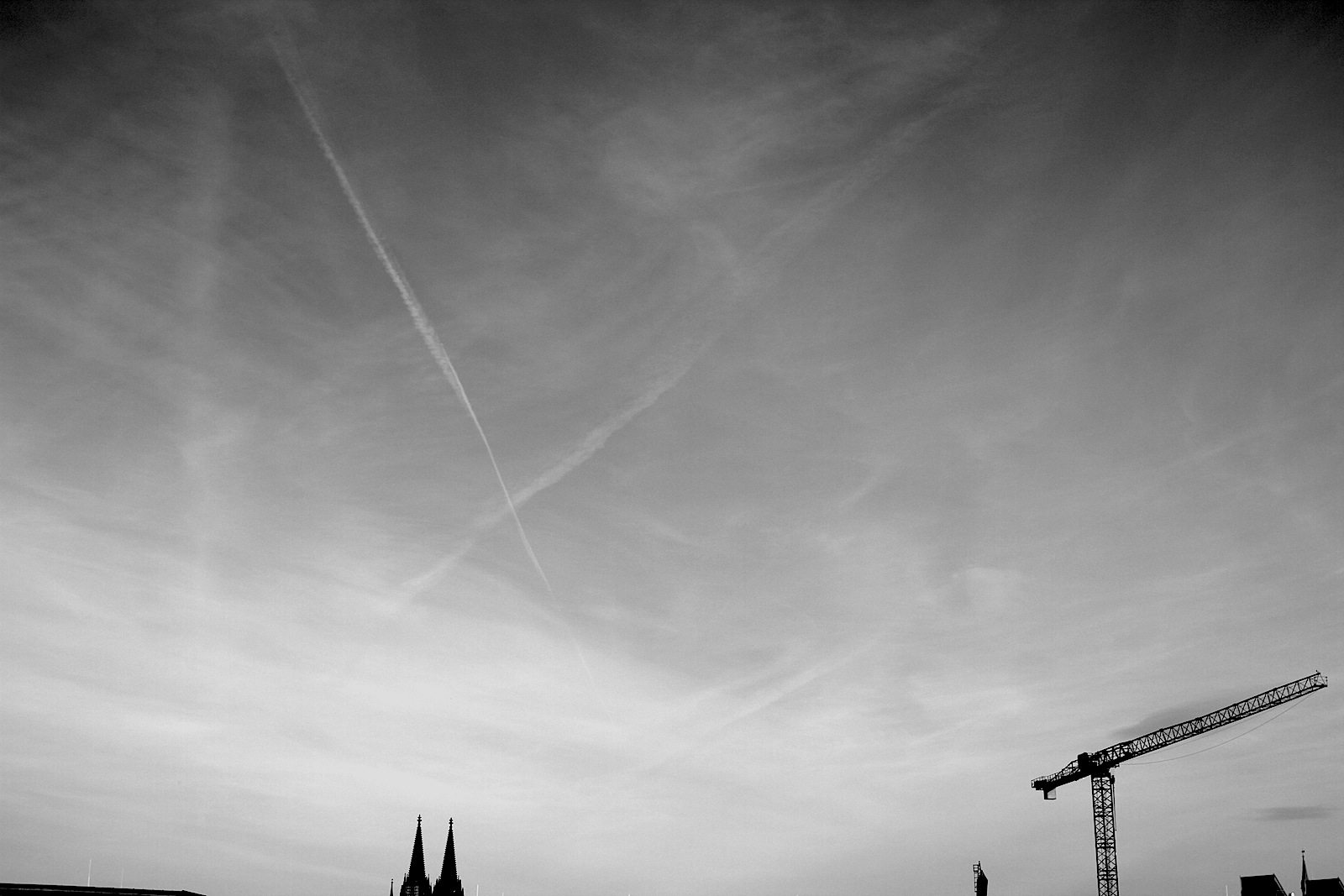
Cologne and its sky
Around 250 companies with 5,000 employees have settled in the MediaPark, 600 people live here, and additional 4.5 million visitors come to this urban quarter every year. The Messe and MediaPark tour comes with surprises and great views, like this one from the playground close to the pedestrian bridge to the Herkulesberg.
»An especially striking example of a very early, pronouncedly large-format and largely successful urban service delivery. «
Stefan Köhler, German National Library of Economics – Leibniz Information Centre for Economics on the MediaPark
Home and hotels
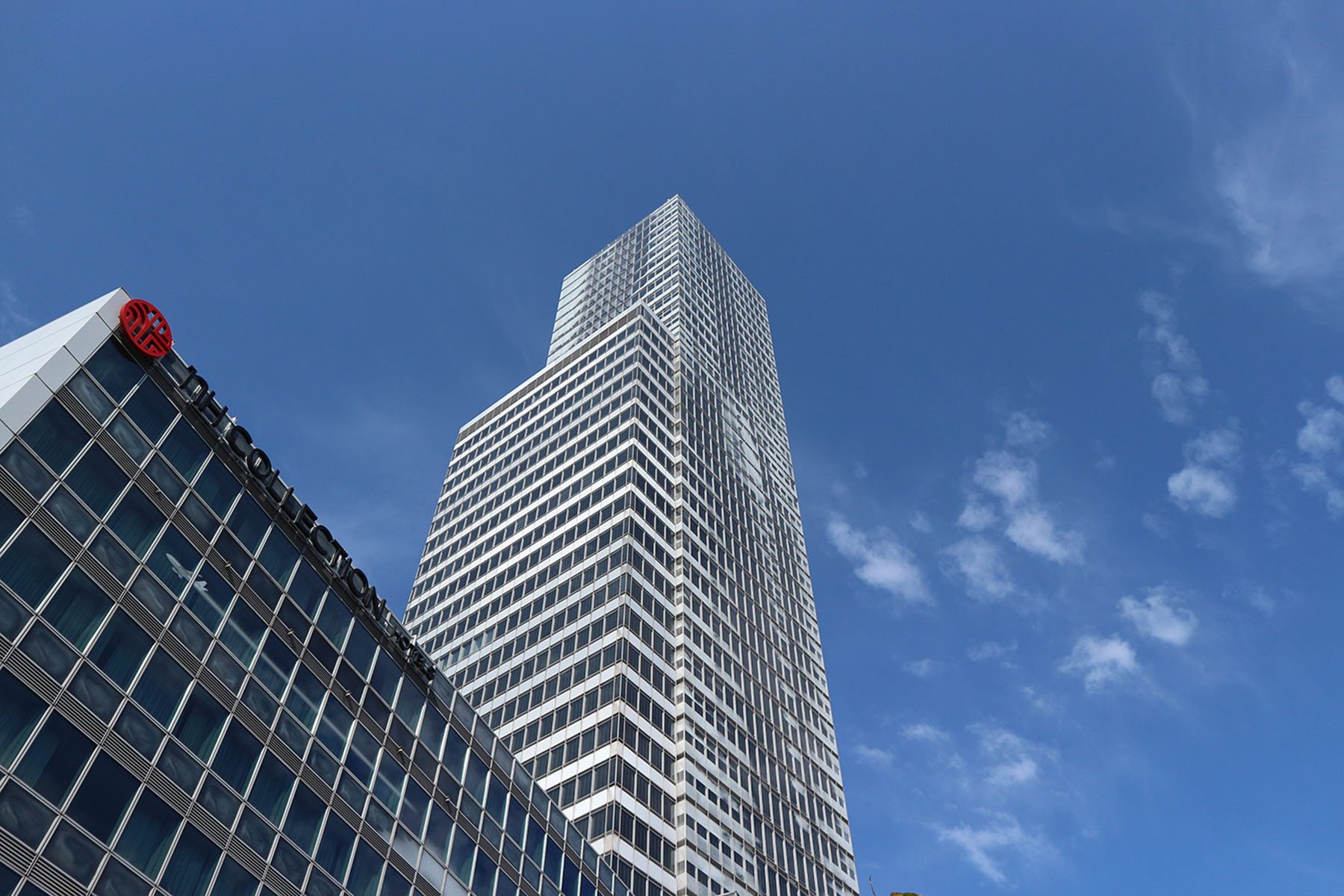
NH Collection Köln Mediapark
Having spent the night in quite a few hotels for research, we recommend the NH Collection Köln MediaPark Hotel and the Hotel Chelsea. The former is part of the Cologne Tower complex by Jean Nouvel and a cool, sleek business hotel.
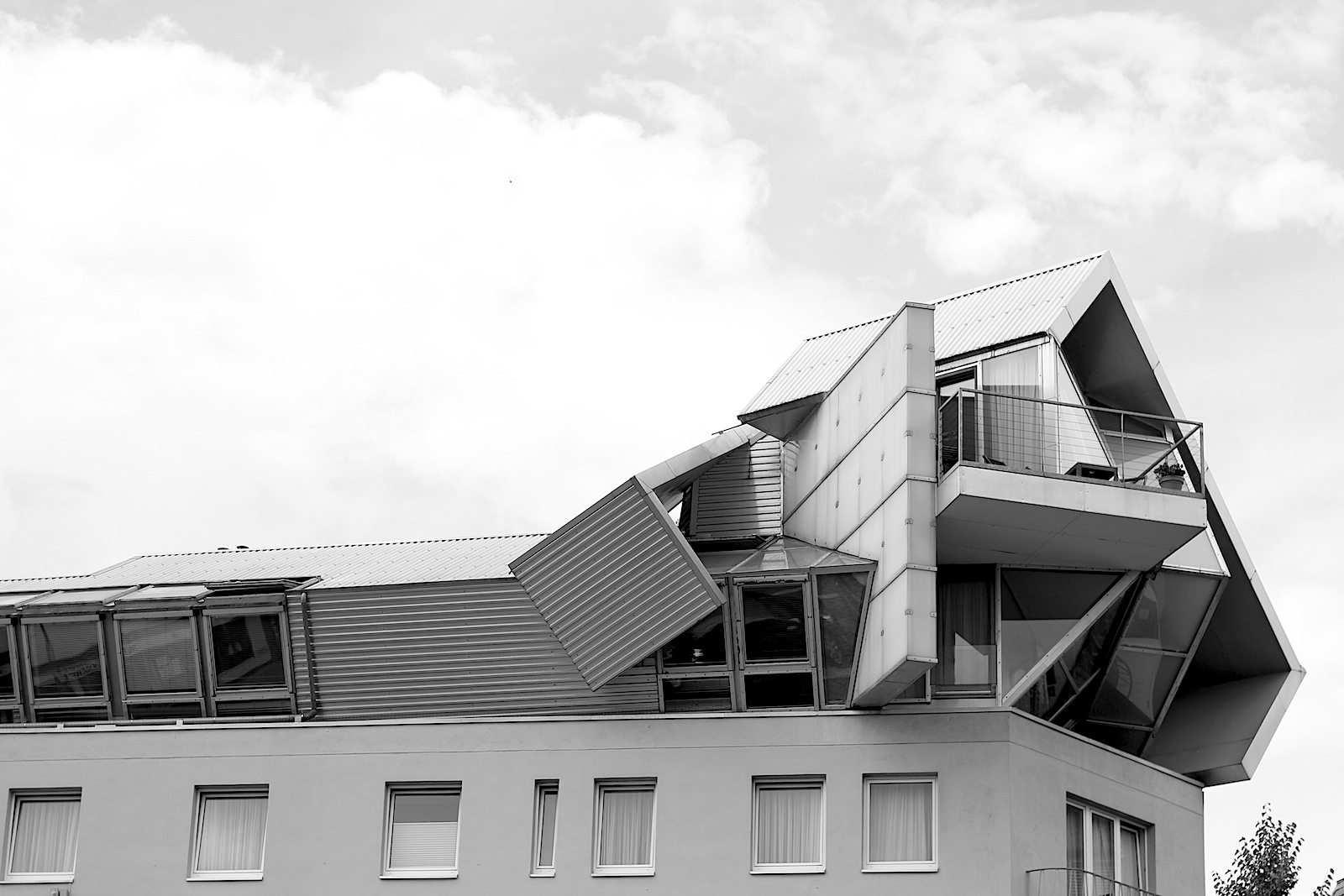
Hotel Chelsea
One of our favourite accommodations in Cologne is the Hotel Chelsea, with its individual, charming character. On the top floor – built in deconstructivist architecture – most rooms have their own terrace, some rooms there are two-storied.
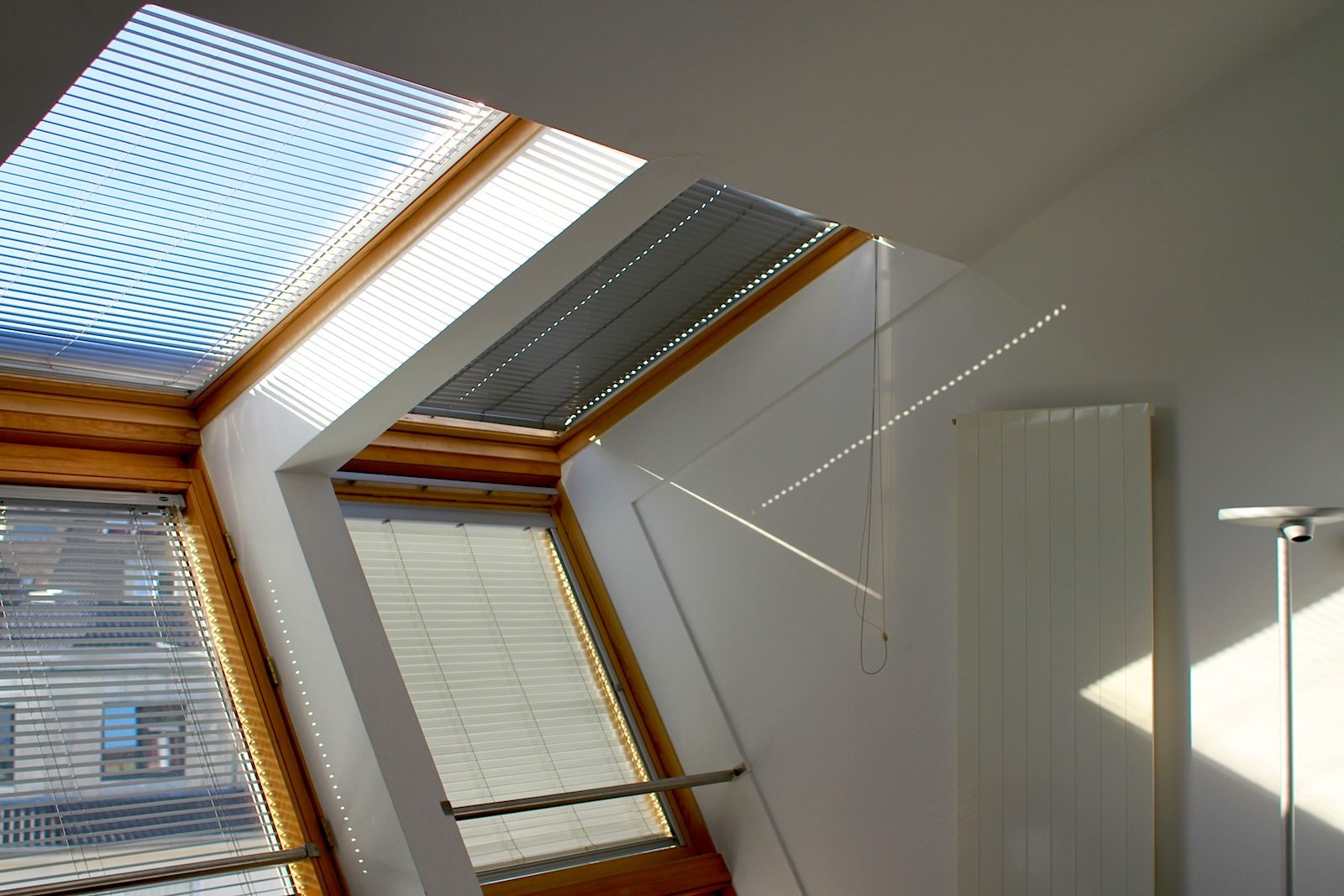
Hotel Chelsea
is often called an art hotel. But foremost it is a house for guests, where everybody is welcome and where those who esteem a taste for the individual feel comfortable. Nevertheless, it is true, that for more than 30 years the Chelsea has been residence, indeed "home away from home" for many artists. The photo shows the French Superior room.
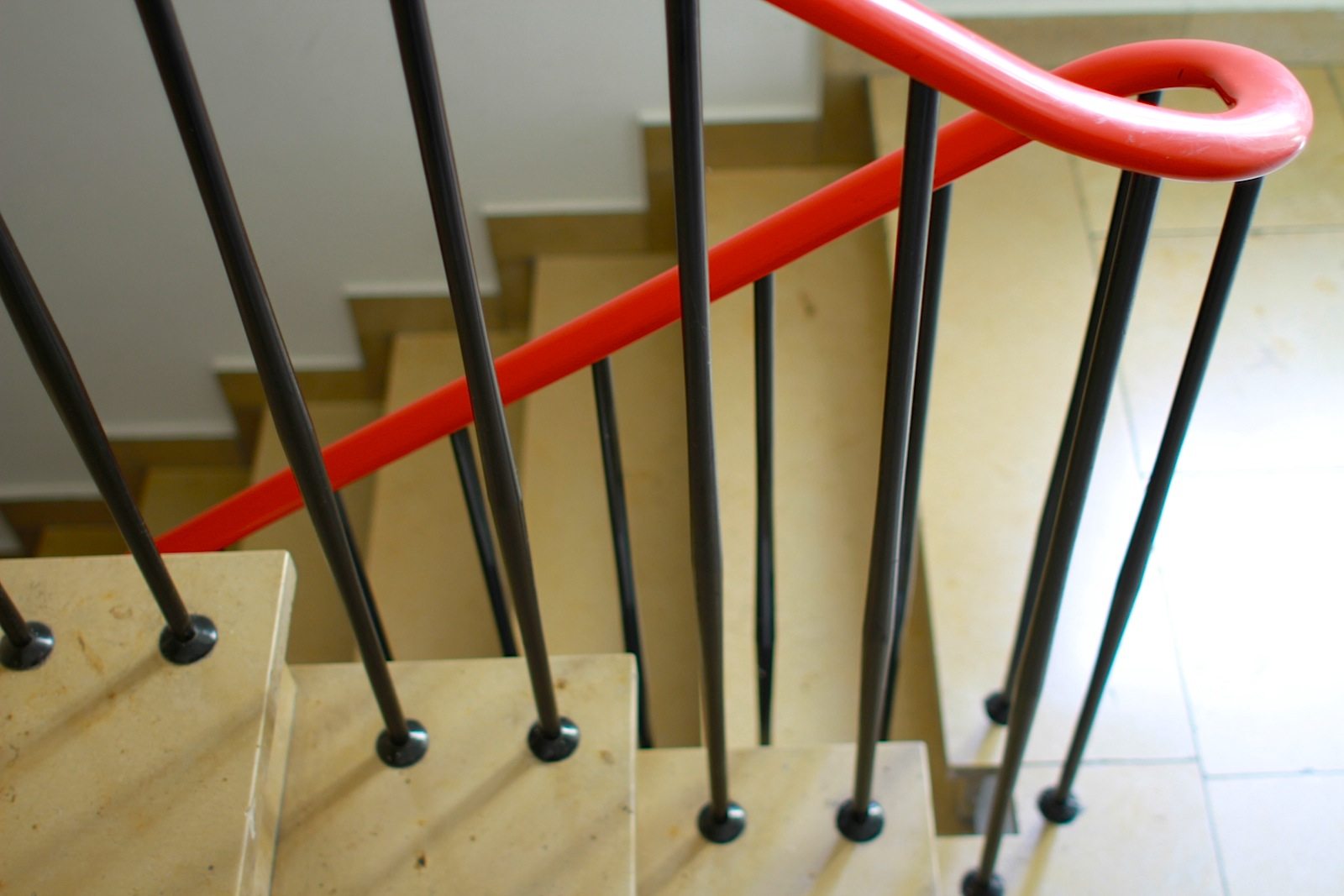
Hotel Chelsea
Inside the unpretentious building from the 1960s.
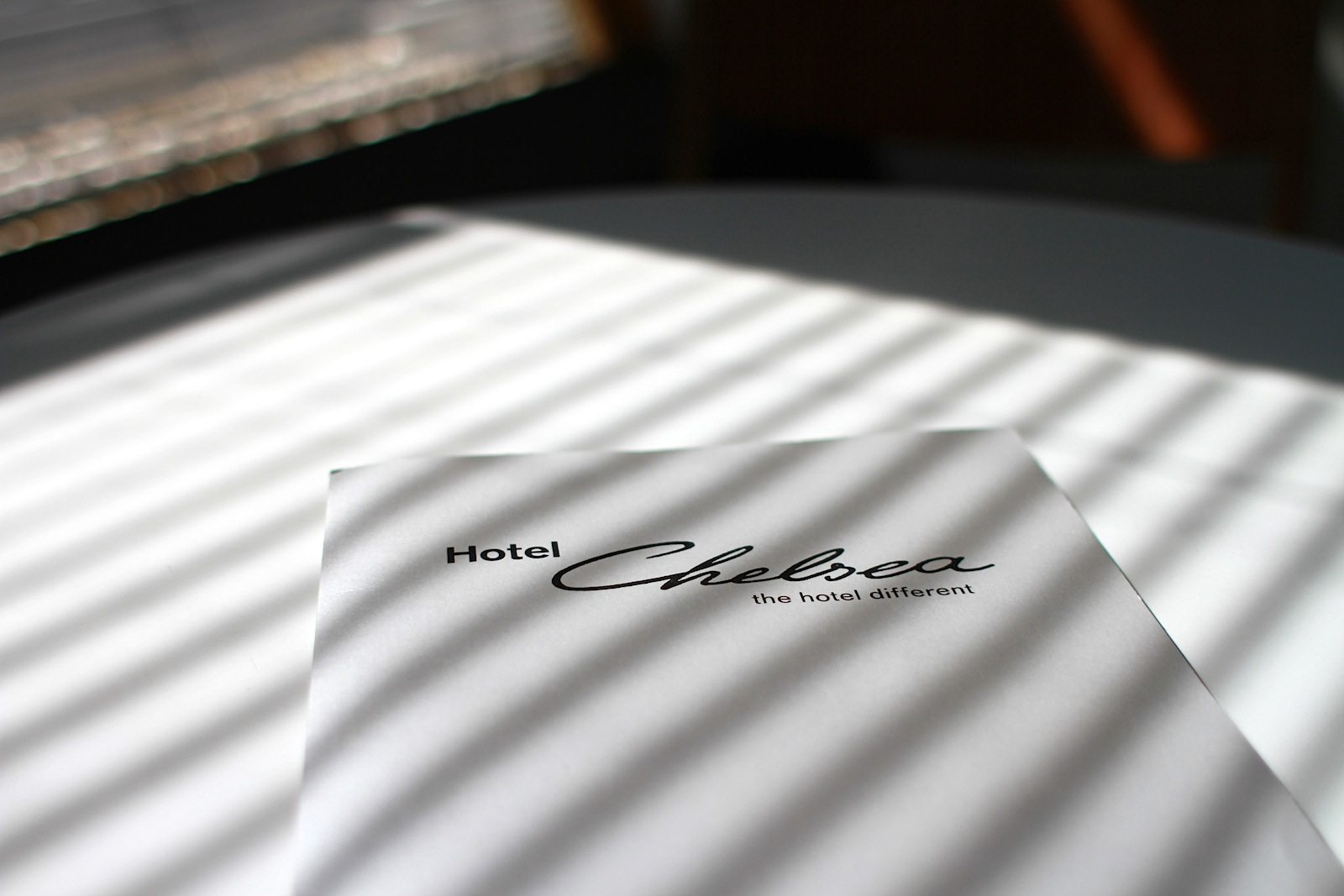
Hotel Chelsea
with its individual, charming character and 39 rooms, including 4 suites.
»We don’t know it, we don’t need it, moving on.
(Be critical if innovations get out of hand.)
«"Kölsches Grundgesetz" or Cologne Constitution with 11 sayings ("op Kölsch") about life.
Koelnmesse
Founded in 1924 by the chancellor Konrad Adenauer, Koelnmesse generates more than one billion Euroin turnover per year in Cologne and the surrounding region. The company is represented in more than 100 countries. Koelnmesse is the number 1 trade-fair location for numerous industries. Visitors and exhibitors from all over the world come to Cologne in order to present the latest trends at the world’s sixth largest exhibition centre and do business worldwide. Every year, Koelnmesse organises and conducts about 80 trade fairs, exhibitions, guest events and special events in Cologne and in the most important marketsworldwide. The events regularly organised by Koelnmesse attract more than 50,000 exhibiting companies from 127 countries, as well as approximately 3 million visitors from 210 countries. The Cologne trade fair company has a more than 90-year-old history. In May 1924, opened in Cologne Deutz. During the economic miracle of post-war era, the "Rheinische Messe" rose to a global marketplace. With more than 600 million Euro, Koelnmesse 3.0 is the most comprehensive investment programme in the company’s history, which will run from 2015 to 2030. The focus will be on the modernisation of the southern section of the exhibition grounds, which cover more than 200,000 square metres. The work will include optimisation of the traffic routes and the guidance systemfor visitors. A further complex will comprise logistics and parking areas near the exhibition grounds. New buildings such as the Hall 1plus, CONFEX® and the new East-West-Terminal will give the exhibition grounds a completely new structure and a new dimension of quality.
MediaPark
Formerly an abandoned freight station, now an architectonically exceptional multi-cluster location - the MediaPark has without doubt become Cologne’s most important urban development project of the 1990s. The MediaPark is a multifaceted and architectonically diverse place to live and work in the heart of the cathedral city. Around 250 companies with 5,000 employees have settled here, 600 people live here. And additional 4.5 million visitors come to this urban quarter every year. International urban architecture ideas competition in 1987, winner: Prof. Dr. Eberhard Zeidler, Toronto. Landscape architect: Jürgen Schubert, Cologne.
KölnTriangle
Address: Ottoplatz 1. 50679 Köln. Opening hours observation deck: 1. Oct-30. April: on weekdays 12-8 p.m. 1. May-30. September: on weekdays 11 a.m.-11 p.m.
THE LINK tip
Having spent the night in quite a few hotels for research, we recommend the NH Collection Köln MediaPark Hotel and the Hotel Chelsea. The former is part of the KölnTurm complex by Jean Nouvel and a cool, sleek business hotel. Its location in the middle of the MediaPark is a big plus. One of our favourite accommodations in Cologne is the Hotel Chelsea, with its individual, charming character. The 39-room hotel has developed into an art hotel in the 30 years of its existence. The rooms are ornamented with works from, among others, Martin Kippenberger, Andreas Schulze and Georg Dokoupil. The exterior of the Chelsea is a work of art as well. Since its renovation in 2001, a deconstructionist folded and kinked roof has grown out of the sleek 1960s building—a landmark and reference point of the Belgisches Viertel. An equally solid element of the place is the hotel’s Café Central, with good traditional fare and the butteriest breakfast croissants ever—delicious! Address: Hotel Chelsea, Jülicher Str. 1, 50674 Cologne.